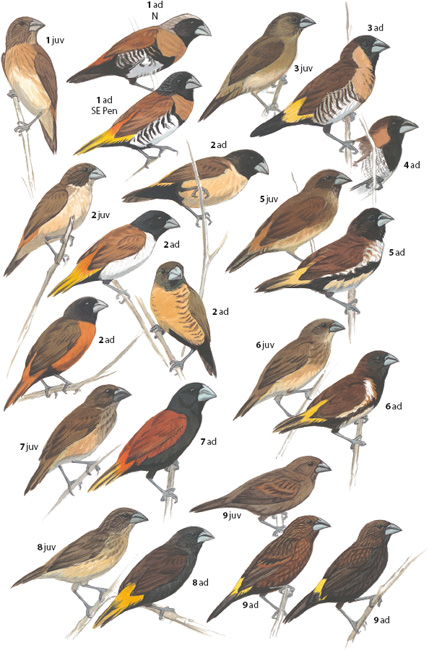PLATE 56 SMALL OWLET-NIGHTJARS

|
1 Wallace’s Owlet-nightjar Aegotheles wallacii
20–23 cm. Hill and lower montane forest, plus flat lowland forest near foothills. Rare and sparsely distributed. All plumages blackish above without distinct pattern. Buffy chin, throat contrast with dark neck. Note white, streaky spots on scapulars and wing-coverts, lacking in Barred ONJ. Voice a series of rapid, squeaky whistles, per pew-pew, or peer pew, or variation. |
p. 379 |

|
2 Mountain Owlet-nightjar Aegotheles albertisi
18–20 cm. Mountain forests. Common. Lacks white facial and breast streaks of the larger Feline ONJ. Plumages highly variable. Breast with irregular dark spots and streaks. Compared with Archbold’s ONJ, Mountain is usually more finely patterned, often less color-saturated, with barring on sides of neck, and tail bars usually broken. Voice a steady series of explosive squeaks, ~1/sec, ee! … ee! … ee! …. |
p. 380 |

|
3 Archbold’s Owlet-nightjar Aegotheles archboldi
18–20 cm. Counterpart of Mountain ONJ in high mountains of W and Border Ranges. Compared with Mountain, more richly colored and coarsely mottled; breast more heavily marked and barring obscure; tail bars usually solid. |
p. 380 |

|
4 Allied Owlet-nightjar Aegotheles affinis
23 cm. Lower montane forests of Bird’s Head. Like Barred ONJ but with brownish cast, and bird thickly feathered, producing plump shape with large head. Head coarsely patterned. Most birds show a distinct pale collar. Voice undescribed. |
p. 381 |

|
5 Barred Owlet-nightjar Aegotheles bennettii
20–23 cm. The common owlet-nightjar of lowland and hill forest and edge. Slender. Dark charcoal grey, finely barred. (A few mainland birds with brownish cast; D’Entrecasteaux Is birds always with buffy cast.) Lacks brown on cheeks, unless plumage brownish. Voice an unevenly paced series of muffled yapping barks, suggests a small dog, ap … ap … ap … ap. … Subspp groups shown: bennettii (mainland NG) usually charcoal grey and lacks streaking down breast; terborghi (E Ranges: Karimui) similar to bennettii but much larger; plumifer (SE Is: D’Entrecasteaux Is) buffy; breast with shaft streaking and barring (upper left corner of plate). |
p. 380 |

|
6 Australian Owlet-nightjar Aegotheles cristatus
23–24 cm. The pale owlet-nightjar of southern savannahs. Medium grey above (paler than Barred ONJ), with mostly white breast and belly (these usually more darkly barred in Barred ONJ). Some birds with brown wash. Always some buff on cheeks. Birds of Port Moresby area are same size as Barred; Trans-Fly birds are larger. Voice a repeated shriek. |
p. 381 |
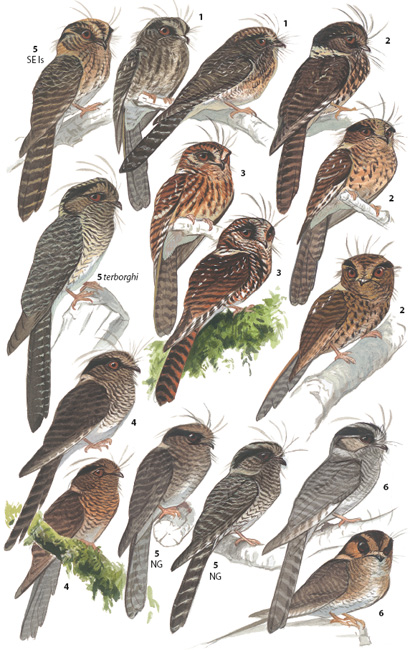
PLATE 57 SWIFTS AND TREESWIFT

|
1 Glossy Swiftlet Collocalia esculenta
9 cm. Common and widespread, from the foothills to above timberline; avoids extensive flat country and savannah. Smallest NG swift. The only swiftlet with glossy blue upperparts and whitish belly. Underwing all dark (see Papuan Spinetailed Swift). |
p. 382 |

|
2 Moustached Treeswift Hemiprocne mystacea
28–30 cm. Lowlands and foothills, at forest edge. Common. A very large swift with long, thin wings and long, deeply forked tail. Adult grey with white eyebrow and moustache. Male has chestnut on ear-coverts, lacking in Female. Juv mottled with brown. |
p. 381 |

|
3 Mountain Swiftlet Aerodramus hirundinaceus
11–13 cm. The grey-brown swiftlet most often seen in the highlands, but not separable from Uniform S in the field. In the hand, Mountain S larger, tarsus usually feathered. |
p. 382 |

|
4 Uniform Swiftlet Aerodramus vanikorensis
13 cm. The grey-brown swiftlet most often seen at low elevations, indistinguishable from Mountain S in the field, but of smaller size and tarsus usually not feathered. |
p. 383 |

|
5 Three-toed Swiftlet Aerodramus papuensis
14 cm. Uncommon and local in foothills and mountains. Large size, closest to Bare-legged S, but head smaller, body slimmer like Mountain S. The only swiftlet with 3 toes. |
p. 383 |

|
6 Bare-legged Swiftlet Aerodramus nuditarsus
14 cm. A rare montane swiftlet. Largest NG swiftlet, with large-headed profile. Grey-brown above, evenly lead-grey below. Tarsus bare. White fringe on eyebrow is unique. |
p. 383 |

|
7 Papuan Spinetailed Swift Mearnsia novaeguineae
11 cm. Uncommon in lowlands. Unique stubby shape and short tail. Color resembles Glossy S, but note pale stripe in the underwing of S race. Subspp shown: novaeguineae (S Lowlands and SE Pen) throat grey; buergersi (NW Lowlands and Sepik-Ramu) throat dark, like back. |
p. 383 |

|
8 Fork-tailed Swift Apus pacificus
18 cm. A Palearctic migrant. Common over Trans-Fly savannah, rare elsewhere. Long, thin, curved wings and long tail. White rump and long, forked tail diagnostic. Chin and throat white; rest of underparts scaled white. |
p. 384 |
|
9 White-throated Needletail Hirundapus caudacutus
19 cm. An uncommon Palearctic migrant, mainly in lowlands. Largest NG swift. Adult shows unique combination of white throat and undertail, otherwise dark below. Juv has smaller white patches on forehead and scapulars; upperparts less glossy. |
p. 384 |
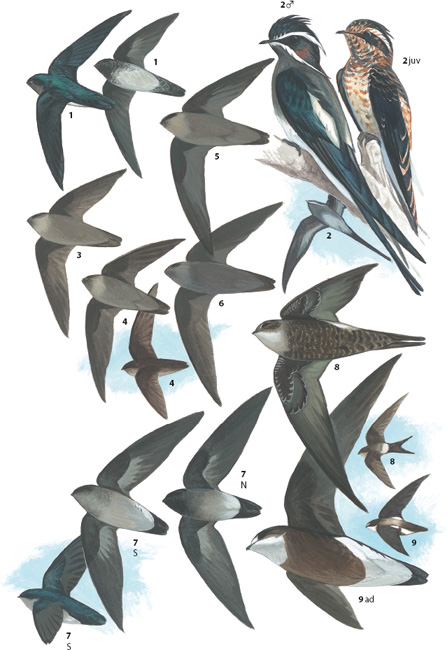
PLATE 58 SWALLOWS
|
1 Sand Martin Riparia riparia
12 cm. Vagrant from Asia during austral summer. Adult a small brown swallow with clean white underparts divided by a breast band. Juv upperparts pale-scalloped and throat buff-tinged. |
p. 495 |

|
2 Fairy Martin Petrochelidon ariel
12 cm. A rare AU migrant to S NG during austral winter. Small swallow with white rump and rufous cap. Tail notched. Adult crown bright rufous, back glossy blue-black. Juv crown paler with some black streaking, back dull brownish black. |
p. 496 |

|
3 Tree Martin Petrochelidon nigricans
12 cm. A common and widespread AU migrant during austral winter. Small, black-and-white swallow with white rump patch. Adult forehead rufous, back glossy black. Juv forehead paler buff, back dull brownish black. |
p. 496 |

|
4 Pacific Swallow Hirundo tahitica
13 cm. The only resident NG swallow, common in cities, towns, and open areas. Adult upperparts glossy black; throat rufous brown blending into grey breast and belly. Transition is gradual between dark throat and pale breast, unlike sharp contrast in Barn S. Tail short and notched, lacking streamers, same in both sexes. Juv not glossy. Subsp shown: frontalis (most of NG) darker underparts, tail spots very small. Not shown is albescens (Trans-Fly to SE Pen) paler underparts, tail spots larger. |
p. 495 |
|
5 Welcome Swallow Hirundo neoxena
13–17 cm. Australian vagrant to NG south coast. Adult similar to Pacific S but with long tail wires (longest in Male) and broader white subterminal tail-band. Juv similar to Pacific S. |
p. 496 |

|
6 Barn Swallow Hirundo rustica
15–18 cm. A rare to locally common Asian migrant. Adult with long tail wires (longest in Male), clean white underparts, dark reddish face, and obvious black throat band. Juv overall duller with paler face and shorter tail. |
p. 495 |

|
7 Red-rumped Swallow Cecropis daurica
16–17 cm. An uncommon and irregular Asian migrant during austral summer. A fork-tailed swallow with orange rump and pale underparts with dark streaking. Adult with back glossy blue-black, rump orange, long tail wires (longest in Male). Juv back brownish black without gloss, rump buff, outer tail feathers pointed and protruding, but no wires. |
p. 496 |
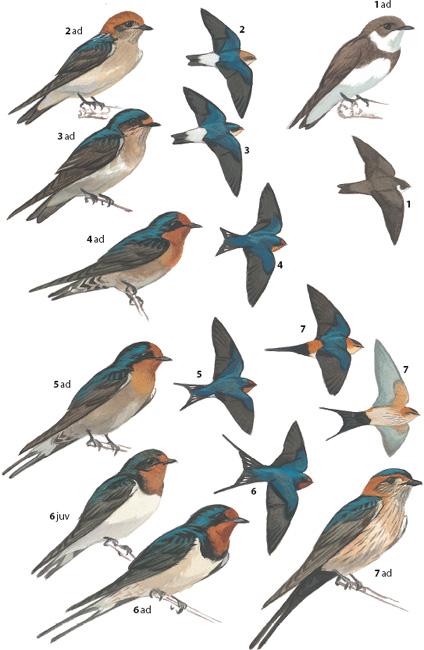
PLATE 59 PARADISE-KINGFISHERS

|
1 Little Paradise-Kingfisher Tanysiptera hydrocharis
31 cm. Riverine forests of S NG and Aru Is. Uncommon and local. Adult nearly identical to Common PK, but smaller, outer tail feathers all blue, and crown and wing-coverts dark blue (not pale blue). Juv distinguished by size and dark blue crown, if present. |
p. 386 |

|
2 Common Paradise-Kingfisher Tanysiptera galatea
33–43 cm. The familiar paradise-kingfisher of mainland NG lowland forest. Usually common, inconspicuous, yet vocal. Adult has white breast and contrasting pale blue crown and wing-coverts; note mostly white outer tail feathers on the long, flag-tipped tail. Juv mostly brown with some crown feathers edged blue; bill all or partly black. |
p. 385 |

|
3 Rossel Paradise-Kingfisher Tanysiptera rosseliana
35–36 cm. Rossel I. Common in lowland forest. Adult similar to Common PK, but much less contrast between crown, back, and wings, and base of tail all white. Shorter tail. |
p. 386 |
|
4 Kofiau Paradise-Kingfisher Tanysiptera ellioti
33 cm. Kofiau I. Common in lowland forest. Adult similar to Common PK, but tail shorter, thicker, and all white. |
p. 386 |

|
5 Biak Paradise-Kingfisher Tanysiptera riedelii
35–36 cm. Biak I. Common in lowland forest and second growth. Adult with pale blue head. |
p. 386 |
|
6 Numfor Paradise-Kingfisher Tanysiptera carolinae
36–38 cm. Numfor I. Common in forest and gardens. Adult dark blue. Juv duller; underparts whitish or rufous marked with black; bill starts out dark. |
p. 386 |

|
7 Buff-breasted Paradise-Kingfisher Tanysiptera sylvia
37 cm. A rare, local resident in monsoonal lowland and hill forests of SE Pen. Also an uncommon austral winter migrant to much of lowland NG, in monsoonal forest and rainforest. Note whitish patch on dark back. Adult with buffy orange breast. Female has blue margins on central tail feathers and variable dusky streaking on white back and rump. Juv duller with dark-marked breast and buff-scalloped wing-coverts. |
p. 387 |

|
8 Red-breasted Paradise-Kingfisher Tanysiptera nympha
32 cm. Patchy range. Locally common mainly in hill forest, also lowlands and mangroves. Adult has red-orange breast and blue crown. Juv similar to juv Brown-headed PK but shows blue in crown. |
p. 387 |

|
9 Brown-headed Paradise-Kingfisher Tanysiptera danae
28–30 cm. Locally common in forest mainly in foothills, occasionally nearby lowlands. Adult has red-orange breast and all-brown head. Juv has red-orange wash on breast and pink rump and lacks blue on head. |
p. 387 |
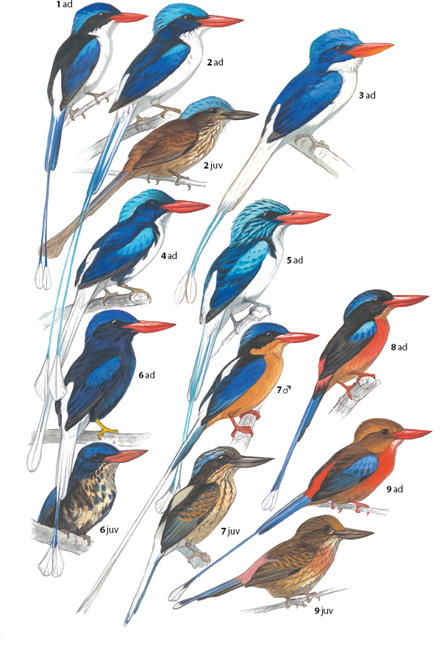
PLATE 60 DOLLARBIRD, BEE-EATERS, AND LARGE KINGFISHERS

|
1 Oriental Dollarbird Eurystomus orientalis
25–28 cm. Open habitats in lowlands and hills. Resident race uncommon. Migratory AU race common during austral winter. Chunky with large head and broad bill. In most situations appears all dark. Wings have pale “silver dollar” marks. Juv blackish; bill blackish. Subspp shown (distinguished with care): waigiouensis (resident) brighter greenish blue; pacificus (migratory, breeds AU) paler grey-blue. |
p. 384 |

|
2 Rainbow Bee-eater Merops ornatus
25 cm. Widespread, common AU migrant during March–October. Very local resident breeder. Occupies open habitats. Adult has black throat bar, much rufous in wing, and squared, black tail with thin tail wires. Juv lacks throat bar and tail wires. |
p. 394 |

|
3 Blue-tailed Bee-eater Merops philippinus
27–29 cm. Local resident in lowland grassland and other open habitats. Common. Adult compared with Rainbow BE: wings all green; tail longer, more tapered and blue; brown throat blending into breast without a black collar. Juv duller than Adult and lacks tail wires. |
p. 393 |

|
4 Rufous-bellied Kookaburra Dacelo gaudichaud
28 cm. The common, lowland forest kookaburra. Male has a blue tail, Female brown. Juv bill blackish and underparts with dark scalloping. |
p. 389 |

|
5 Shovel-billed Kookaburra Clytoceyx rex
32 cm. Rare and local in interior of forest from lowlands to mid-mountains. Often flushed from the ground where it has been digging. Bill broad and rounded at the tip. Male tail blue, Female’s brown. Juv similar to Female, but upperparts with rusty-tip feathers, underparts with dark scalloping. |
p. 388 |

|
6 Blue-winged Kookaburra Dacelo leachii
38–40 cm. Savannah and edge of monsoon forest. Largest NG kingfisher. Male’s tail blue; Female’s barred brown and blue. Juv buffier with heavier barring in underparts. |
p. 388 |

|
7 Spangled Kookaburra Dacelo tyro
33 cm. Monsoonal forest and adjacent savannah in Trans-Fly and Aru Is. Common. Smaller than Blue-winged K. Adult head and mantle darker and spangled; iris dark; tail all blue, lacking white in outer tail feathers. Female, blue parts greenish blue. Juv head and back darker than Adult; underparts darker-scaled. Subsp shown: archboldi (Trans-Fly) whitish spangling and underparts. Not shown is tyro (Aru Is) with buff spangling and underparts. |
p. 389 |

|
8 Hook-billed Kingfisher Melidora macrorrhina
25 cm. Interior of lowland and hill forest and patchy regrowth. Common. An inveterate caller at dawn and dusk, but difficult to observe. Unique striped facial pattern. Male’s crown scalloped blue, Female’s darker. Juv breast darker-scalloped. |
p. 388 |
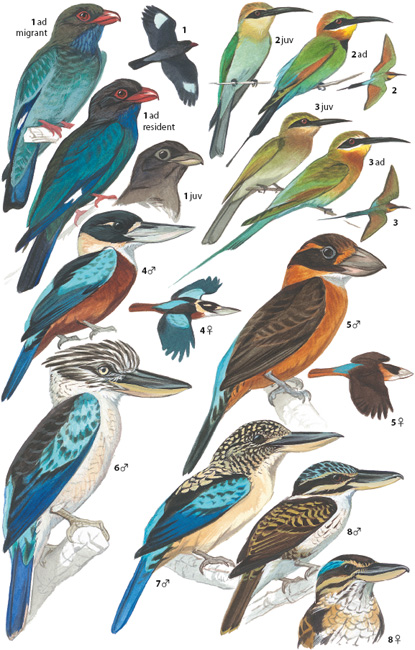
PLATE 61 MEDIUM KINGFISHERS

|
1 Blue-black Kingfisher Todiramphus nigrocyaneus
23 cm. Rare in lowland forest, often near streams. Deep, glowing blue with diagnostic black mask and back. Male belly dark blue or rufous. Female underparts white with a blue breast band. Juv upperparts like Adult but duller; underparts dingy white with rufous breast band, faintly scaled. Subspp shown (only Males differ): stictolaemus (central S Lowlands to SE Pen) underparts blue-black; quadricolor (Yapen I, NW Lowlands to Sepik-Ramu) rufous belly; nigrocyaneus (NW Is, Bird’s Head to western S Lowlands) white throat and breast band. |
p. 389 |

|
2 Forest Kingfisher Todiramphus macleayii
20–21 cm. Resident and austral winter migrant in open habitats in lowlands and hills. Uncommon. Crown deep blue. White forehead spots and underparts. Unique white wing patch. Female’s nape blue, not white. Juv upperpart buff-edged; underparts scalloped. Subspp shown: macleayii (resident) bright blue back; incinctus (AU migrants) greenish-blue back. |
p. 390 |

|
3 Beach Kingfisher Todiramphus saurophagus
28 cm. Seacoasts, especially on small, offshore islands. Local. Inhabits strand, mangroves, coconut groves. Only white-headed kingfisher in NG Region. Massive bill. Female mantle sometimes more greenish. Juv head and underparts buffy; upperparts buff-scaled. |
p. 390 |

|
4 Collared Kingfisher Todiramphus chloris
20–25 cm. Mangroves and other coastal habitats. Uncommon. Adult heavy-billed with white collar and a blue-green crown and back. Underparts white. Female often duller. Juv with faint buff scaling in upperparts; obscure dark scaling on underparts and collar. Subspp shown: chloris (NW Is, Bird’s Head and Neck, also Wallacea) coastal; bright bluish green; sordidus (NG south coast and Aru Is, also AU) mangroves; dusky olive green; colonus (SE Is) small islands; darker, smaller than sordidus and Sacred K. |
p. 390 |

|
5 Sacred Kingfisher Todiramphus sanctus
21 cm. Common austral winter migrant to open habitats at low to mid-elevations, where it is the most common kingfisher. Adult underparts and collar buffy white with variable degree of dark edging. Cap and back greenish. Juv has buff scaling in upperparts. |
p. 391 |
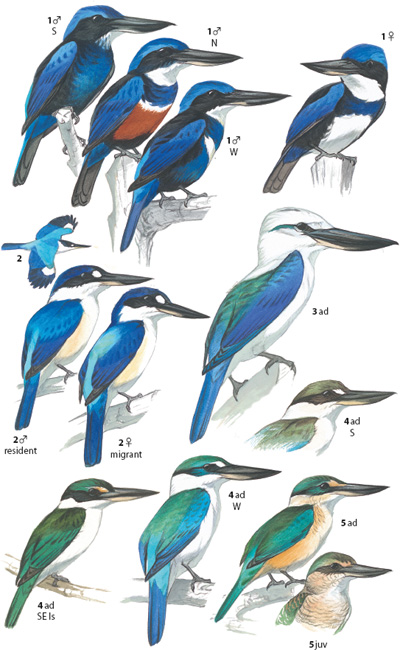
PLATE 62 RIVER AND YELLOW-BILLED KINGFISHERS

|
1 Azure Kingfisher Ceyx azureus
16 cm. Along any body of freshwater or tidal creek with adequate cover. Common. A deep blue kingfisher with evenly dark blue crown and upperparts and black bill with pale tip. Breast variable—rufous to cream. Juv has blackish forehead and sides of breast. |
p. 393 |

|
2 Common Kingfisher Alcedo atthis
14–15 cm. Local and habitat-specific in the NG Region. Along coasts, mangroves, rivers. Smaller and brighter than Azure K. Sky blue streak up the back, obvious in flight. Female has red in lower bill. Juv duller, with some dusky-edged feathers on breast. |
p. 392 |

|
3 Papuan Dwarf Kingfisher Ceyx solitarius
12 cm. Not associated with water. Lowland and hill forest. Common. Adult crown and wing-coverts with glittering, sequined feathering; back and rump paler blue. Juv duller, may have scaling on breast. |
p. 392 |

|
4 Little Kingfisher Ceyx pusillus
11 cm. Mangroves and small, lowland creeks and pools. Common. Smallest NG kingfisher. Adult is the only small kingfisher with white underparts. Juv’s greenish-blue crown appears barred; hint of buff in underparts and black edging. |
p. 393 |

|
5 Yellow-billed Kingfisher Syma torotoro
18–20 cm. Lowland and hill forest. Common. Yellow bill lacks black markings. Male crown unblemished yellow-tan; nape has 2 black patches. Female crown has black patch; nape patches often joined. Juv bill entirely or partly black; white nape patch. Subspp shown: torotoro (widespread—all range except next); ochracea (SE Is: D’Entrecasteaux Is) much larger, underparts more ochre. |
p. 391 |

|
6 Mountain Kingfisher Syma megarhyncha
21–23 cm. Montane counterpart to Yellow-billed K. Uncommon. Nearly identical, but larger, with proportionately longer bill. Black marking atop bill (except on Huon). Juv ear-coverts blackish. Subspp groups shown: megarhyncha (Central Ranges) bill with black tip; sellamontis (Huon) bill all yellow. |
p. 391 |
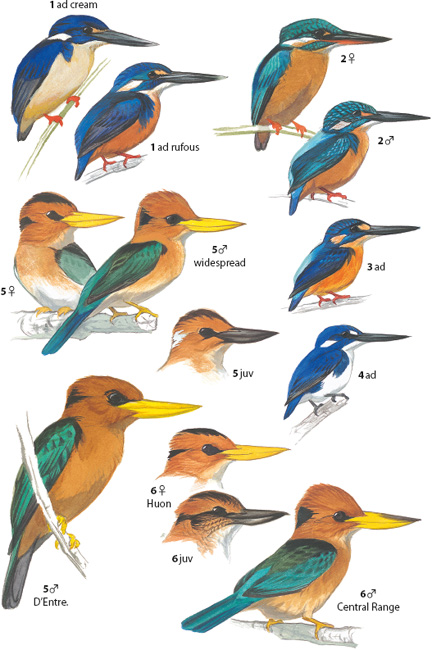
PLATE 63 LARGE, GROUND-DWELLING SONGBIRDS

|
1 Island Thrush Turdus poliocephalus
23–25 cm. Common in alpine shrubland and subalpine woods. Adult unmistakable. Juv dark above, spotted with rufous; below rufous spotted with black. Subspp groups shown: papuensis (NG) all brownish black; canescens (SE Is: D’Entrecasteaux) grey head. |
p. 506 |

|
2 Russet-tailed Thrush Zoothera heinei
21–23 cm. Uncommon, rarely observed; forest floor in hills and mid-mountains. Robust with elongate shape. Large, dark eye; pink legs. Heavily scaled; buff wing bars. In flight note black-and-white patch under the wing and white outer tail feathers. |
p. 506 |

|
3 Papuan Scrub-Robin Drymodes beccarii
20 cm. A lanky, thrushlike terrestrial robin that inhabits forest interior mainly in hills and lower mountains, also locally in S Lowlands. Adult with black vertical bar through eye, white throat, white wing bars, long tail, and long pink legs. Juv has crown feathers edged black, throat and breast flecked brown. Subspp groups shown: beccarii (Bird’s Head to NW Lowlands and Sepik-Ramu) upperparts blackish brown; brevirostris (S Lowlands, Aru Is, SE Pen) upperparts cinnamon. |
p. 490 |

|
4 Lesser Melampitta Melampitta lugubris
18 cm. An uncommon, reclusive ground bird of cloud forests. Distinctive double-click call. An entirely velvet black, pitta-shaped bird. Male’s eye red, Female’s dark brown. Juv dull, sooty black with brownish cast in underparts. |
p. 472 |

|
5 Red-bellied Pitta Erythropitta erythrogaster
15–17 cm. Mainly hill forest. Common, secretive, but vocal resident. Adult has brown head, red belly. Juv brown and mottled, with pale or white throat patch. Subspp shown: macklotii (most of NG Region) greenish back and wings; finschii (SE Is: D’Entrecasteaux Is) blue back and wings. |
p. 395 |

|
6 Hooded Pitta Pitta sordida
15–17 cm. Lowland and hill forest. Common but secretive resident. Sings often. Adult has black hood, green body, shining turquoise shoulder patch. Glittering blue rump patch in Male, reduced or absent in Female. Juv mostly sooty. Subspp groups shown: novaeguineae (NG Region, except next) blue-green flanks, glittering throat-band; rosenbergii (Bay Is) deep blue flanks, lacks glittering throat-band. |
p. 395 |

|
7 Noisy Pitta Pitta versicolor
17–18 cm. Resident in monsoon forest and mangroves of Trans-Fly. Some birds may be migrants from AU. Adult has yellow-tan breast and flanks with black blotch in center. Juv duller and lacking dark chin and throat and dark belly patch. |
p. 396 |
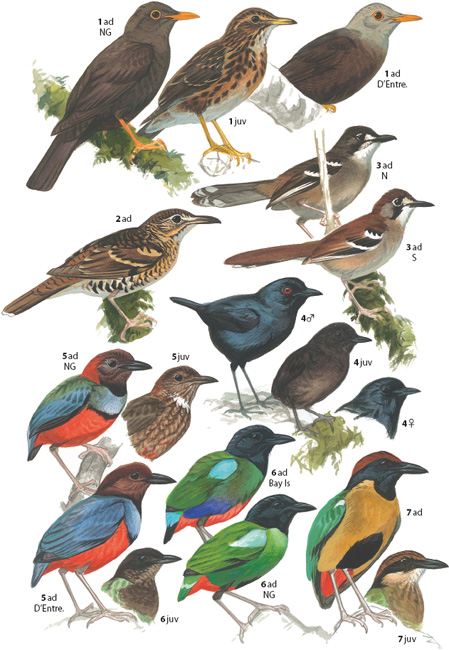
PLATE 64 WHIPBIRDS, JEWEL-BABBLERS, AND LOGRUNNER

|
1 Painted Quail-thrush Cinclosoma ajax
23 cm. Very local in foothill and gallery forests. A grey-brown bird that shows a white facial stripe or throat. Look for white tail tips when flushed. Male boldly patterned. Female has white eyebrow and throat. Juv like Female, but iris paler. |
p. 438 |

|
2 Papuan Logrunner Orthonyx novaeguineae
18 cm. Rarely encountered. A scurrying, quail-shaped ground dweller of wet mid-mountain and cloud forest. Note prominent wing bars and spiny tail. Throat white in Male, orange in Female. Juv mottled throughout. Subsp shown: victorianus (Central Ranges) darker, and black breast border present in Female. Not shown is very similar novaeguineae, lacking breast border (Bird’s Head). |
p. 430 |

|
3 Papuan Whipbird Androphobus viridis
16–17 cm. Rare and seldom seen in cloud forest thickets. Much smaller than Australian whipbirds. Male has white moustachial stripe, black throat. Female all moss green (do not confuse with female Fantailed Berrypecker or juv Rufous-naped Bellbird). Juv darker green with blackish face and underparts. |
p. 436 |

|
4 Spotted Jewel-babbler Ptilorrhoa leucosticta
20 cm. Cloud forest. Uncommon. Adult has white cheek patch on black face and rows of white spots on shoulder. Juv washed olive; wing spots dull. Subspp groups shown: sibilans (Cyclops Mts) green-backed with green breast band; centralis (Bird’s Neck to Border Ranges) brown-backed. Not shown are green-backed leucosticta (Bird’s Head) and loriae (E Ranges, Huon, SE Pen). |
p. 436 |

|
5 Chestnut-backed Jewel-babbler Ptilorrhoa castanonota
23 cm. Mid-mountain forests. Common. White throat, chestnut back, and blue underparts. Male has blue rump and eyebrow. Female rump usually chestnut like back (blue in race uropygialis). Juv dark brownish grey with white throat. Subspp groups shown: castanonota (Bird’s Head, Batanta I) underparts blue, Female with blue eyebrow; pulchra (E Ranges, SE Pen, Huon) Female eyebrow white, tan, or pale blue; Not shown are saturata (W Ranges) and uropygialis (N slope of W Ranges and N Coastal Mts). |
p. 437 |

|
6 Dimorphic Jewel-babbler Ptilorrhoa geislerorum
22–23 cm. Common in lowland and hill forest; hills only where it meets Blue JB. Male similar to male Blue JB, but crown has a brownish tinge. Female brown with white throat. |
p. 437 |

|
7 Blue Jewel-babbler Ptilorrhoa caerulescens
22 cm. Lowland forest. Common. All dull blue with white throat. Sexes generally alike, but see subspp for exceptions. Juv browner. Subspp groups shown: caerulescens (Bird’s Head to Sepik-Ramu) with blue undertail; nigricrissus (S Lowlands, SE Pen) blackish undertail, Female has white eyebrow. |
p. 437 |
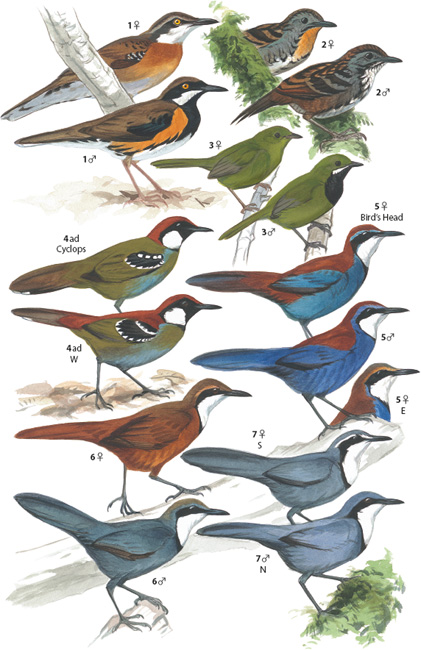
PLATE 65 MOUSE-WARBLERS AND GROUND-ROBINS

|
1 Rusty Mouse-Warbler Crateroscelis murina
12 cm. The mouse-warbler of lowland and hill forest; common. White throat; pale rusty breast. Male, crown usually darker than back. Female and Juv, crown same as back (dark Juv illustrated). Subspp groups shown: murina (species’ range except for next) cinnamon breast; monacha (Aru Is) similar but underparts mostly white. Not shown is pallida (S Lowlands) very pale cinnamon flanks and belly. |
p. 423 |

|
2 Bicoloured Mouse-Warbler Crateroscelis nigrorufa
12 cm. Mid-mountain forest interior. Rare. Narrow elevational range lies above Rusty MW and overlaps lower range of Mountain MW. Adult is uniquely black and rufous. Juv’s extent of rufous varies from only throat to all of underparts. |
p. 423 |

|
3 Mountain Mouse-Warbler Crateroscelis robusta
12 cm. The mouse-warbler of high mountain forest; common. Subspp in 3 groups by plumage; the geography is quite specific for each, but widely scattered:
WHITE-THROATED DICHROMATIC GROUP: White throat and belly divided by a dark breast band in Male, band lacking or faint in Female. Iris of Male white, grey, yellow, orange, red-brown, or brown; of Females mostly red-brown or brown. Subspp robusta (eastern E Ranges, Huon, SE Pen east to Owen Stanley Mts); pratti (far eastern SE Pen) much smaller, darker, stronger pattern; diamondi (Foja Mts) large, also dark with strong pattern. Birds from western and central E Ranges (e.g., Mt Hagen) less patterned, approaching buff-breasted group.
PALE-WASHED MONOMORPHIC GROUP:
All plumages with underparts uniformly pale (peninsularis, Bird’s Head; deficiens, Cyclops Mts).
BUFF-BREASTED MONOMORPHIC GROUP:
All plumages with underparts uniformly rusty brown. Subspp sanfordi, W Ranges and Border Ranges; bastille, N Coastal Mts. |
p. 423 |

|
4 Lesser Ground-Robin Amalocichla incerta
14–15 cm. Cloud forest; widespread, common, and vocal. Similar to Greater GR but smaller and more dainty. Adult, clean brownish breast and conspicuous white forehead spot, throat. Juv, dark scalloped buffy plumage. |
p. 487 |

|
5 Greater Ground-Robin Amalocichla sclateriana
20 cm. Subalpine forest floor; usually rare and local. Robust and long-billed. Note pitta-like shape and thrush size. Adult has whitish throat, grey breast and flanks, with vague, dark scalloping on throat and breast. Juv rufous with dark mottling and scaling. Subsp shown: sclateriana (SE Pen). Not shown: occidentalis (W Ranges) browner. |
p. 487 |
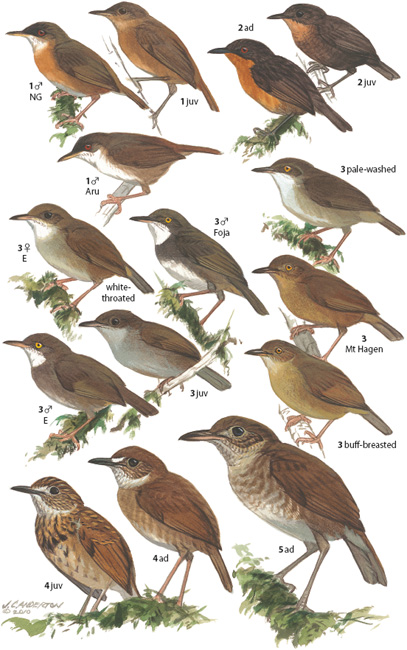
PLATE 66 MAYPOLE BOWERBIRDS AND SATINBIRDS
NOTE: To locate a bowerbird, locate its bower first. These are pictured on plate 67a.

|
1 Vogelkop Bowerbird Amblyornis inornata
25 cm. Bird’s Head and Neck, where it is the only maypole bowerbird. Common in montane forest. Male crestless like Female. Indistinguishable from female Macgregor’s BB. |
p. 398 |

|
2 Golden-fronted Bowerbird Amblyornis flavifrons
24 cm. Foja Mts, where it is the only maypole bowerbird. Common in montane forest. Male has unique golden orange crest, and the forehead is golden too, unlike Macgregor’s. |
p. 398 |

|
3 Streaked Bowerbird Amblyornis subalaris
22 cm. Lower mts of the far SE Pen. Locally common. Shares its range with Macgregor’s BB, which lives mostly at higher elevation. Identified by obscure streaking on throat and breast, smaller size and Male’s shorter crest. |
p. 397 |

|
4 Huon Bowerbird Amblyornis germana
25 cm. Mountains of the Huon Peninsula. Plumages identical to those of Macgregor’s BB, but Male’s crest shorter. |
p. 397 |

|
5 Macgregor’s Bowerbird Amblyornis macgregoriae
26 cm. The common and widespread gardener bowerbird, distributed throughout the Central Ranges. Male’s crest orange. All plumages show an unmarked throat and breast. Vocal, but shy and elusive. |
p. 397 |

|
6 Archbold’s Bowerbird Archboldia papuensis
35–37 cm. A rare and elusive fruit eater of high mountain forest of the Central Ranges. Patchily distributed. Note Male’s black plumage, longish forked tail, and flat, golden crown. Female, Juv, and Imm more greyish than Male; tail is shorter and squared. |
p. 398 |

|
7 Loria’s Satinbird Cnemophilus loriae
20–23 cm. A common fruit eater of the cloud forest canopy. Male is compact and all black with bluish iridescence on forehead and a pale yellow gape. Female and Imm are olive green with brownish wings. Juv is dull grey. Amblyornis bowerbirds are much more brown. Look for Male at his song perch on an exposed branch atop the canopy. |
p. 430 |

|
8 Crested Satinbird Cnemophilus macgregorii
25 cm. A quiet, plump, and retiring frugivore of high mountain cloud forest and subalpine thickets. Uncommon. Seen at fruiting trees. Male unique. Female and Imm brownish olive; note diagnostic forehead groove and grey iris. Juv dull grey. Subspp shown: sanguineus (E Ranges) Male deep orange; macgregorii (SE Pen) Male yellow-orange. |
p. 431 |
|
9 Black Pitohui Melanorectes nigrescens
22–23 cm. For comparison. Female deceptively similar. Note hooked bill. (Upper left corner of plate.) |
Pl. 83, p. 452 |
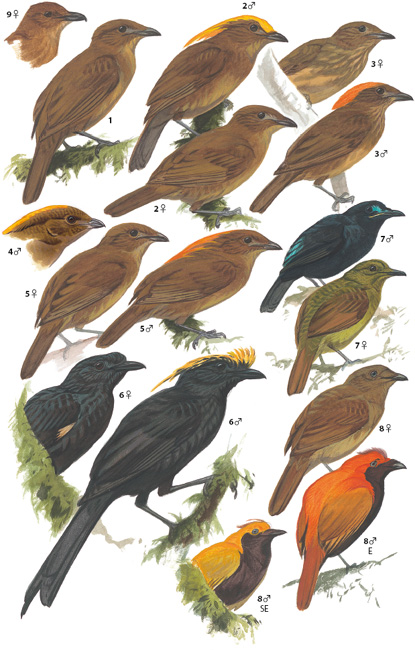
PLATE 67 AVENUE BOWERBIRDS AND SATINBIRDS
NOTE: To locate a bowerbird, locate its bower first. These are pictured on plate 67a.

|
1 Flame Bowerbird Sericulus ardens
25–26 cm. Lowland and foothill forest of S Lowlands. Attracted to patches of regrowth and rubber plantations. Uncommon. Male showy and unmistakable, lacks black mask. Female, Juv, and Imm with yellow breast, but note yellow chin and line down throat, which lack mottling and scalloping; dark iris. Imm Male similar but has white iris. |
p. 399 |

|
2 Masked Bowerbird Sericulus aureus
24–25 cm. Lower montane forests of the North and West. Uncommon. Male unmistakable with orange plumage and black face. Female, Juv, and Imm differ from Flame BB (note that ranges abut) by the dark-scalloped chin and throat (plate shows 2 variations); Imm Male has white iris. |
p. 398 |

|
3 Fire-maned Bowerbird Sericulus bakeri
26–27 cm. Lower montane forests of the Adelbert Range. Uncommon. Look for it at large, fruit-bearing fig trees. Male unmistakable. Female, Juv, and Imm dull grey-brown, pale below with dark scalloping; Imm Male has white iris. |
p. 399 |

|
4 Yellow-breasted Satinbird Loboparadisea sericea
16–18 cm. Rare and patchily distributed. A seldom-seen fruit eater of mid-mountain forest. Male is rich brown above, silky yellow below with yellow rump; a unique, bulbous, blue-green wattle sits atop bill. Female duller than Male and lacks wattles. Juv underparts buffy and streaked. |
p. 431 |

|
5 Fawn-breasted Bowerbird Chlamydera cerviniventris
28–30 cm. Mainly lowlands in transitional thickets between grassland and forest, also edges of mangroves and towns. In mid-mountains of SE Pen and Huon. Note orange-buff breast and belly. Crown pale-streaked. Habits similar to Yellow-breasted BB. |
p. 400 |

|
6 Yellow-breasted Bowerbird Chlamydera lauterbachi
25–28 cm. Margins of grassland, scrub, and forest edge of mid-mountain valleys and Sepik-Ramu lowlands. Locally common, but shy and wary. Most often seen when crossing openings with distinctive, head-up, undulating flight. All plumages have a yellowish breast and belly and an unstreaked crown. Subspp shown: uniformis (western NG and parts of Sepik) dull greenish crown; lauterbachi (Sepik-Ramu and Huon) orange-washed crown. |
p. 399 |
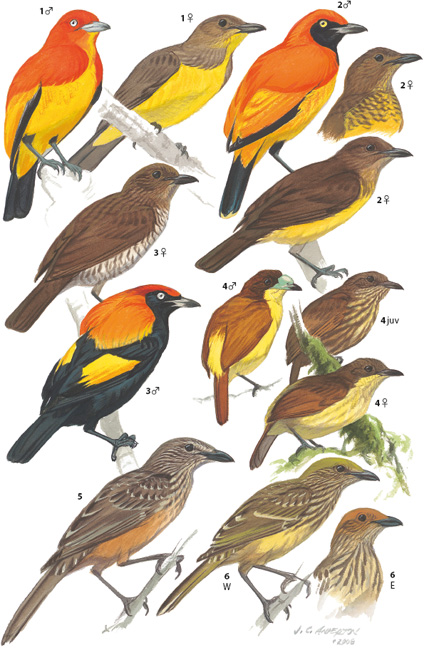
PLATE 67A BOWERBIRD BOWERS
Male bowerbirds build their bowers to attact females for mating. The bower is a stage for his display; the female actually builds her nest elsewhere. Note that bowers vary in size among species; they are not illustrated to scale here.
1 Vogelkop Bowerbird
Bird’s Head and Neck. On a ridge crest or flank in cloud forest. Giant, tented bower. |
p. 398 and plate 66 |
2 Streaked Bowerbird
SE Pen. On ridge flank, not crest, in mid-mountain forest. Hutlike rather than the maypole of co-occurring Macgregor’s BB. |
p. 397 and plate 66 |
3 Macgregor’s Bowerbird
Central Ranges and Adelbert Mts. On a ridge crest in cloud forest. Maypole bower of small twigs built up around a sapling pole surrounded by a circular mossy base of ~1 m diameter with an elevated rim. |
p. 397 and plate 66 |
4 Golden-fronted Bowerbird
Foja Mts. Set atop ridge spine. Bower similar to Macgregor’s but for presence of blue fruit and lack of an elevated perimeter rim. |
p. 398 and plate 66 |
5 Huon Bowerbird
Huon Mts. Set below crest of ridge. Bower lacks perimeter ridge and has a basal mossy column hung with small, colored decorations. |
p. 397 and plate 66 |
6 Archbold’s Bowerbird
Central Ranges, in high-elevation cloud forest. Bower a broad stage of matted ferns shrouded by orchid stems on overhanging branches. |
p. 398 and plate 66 |
7 Flame Bowerbird
S Lowlands. Near a forest opening.
Masked Bowerbird
Lower mountain forests of N and W.
Fire-maned Bowerbird
Lower mountain forests of the Adelbert Range.
Bowers of all three are small structures with 2 parallel walls of sticks. |
p. 399 and plate 67 |
8 Fawn-breasted Bowerbird
Widespread.
Two-walled avenue bower placed in thicket and decorated with green berries. |
p. 400 and plate 67 |
9 Yellow-breasted Bowerbird
Widespread.
Four-walled avenue bower placed in thicket and decorated with berries and pebbles. |
p. 399 and plate 67 |
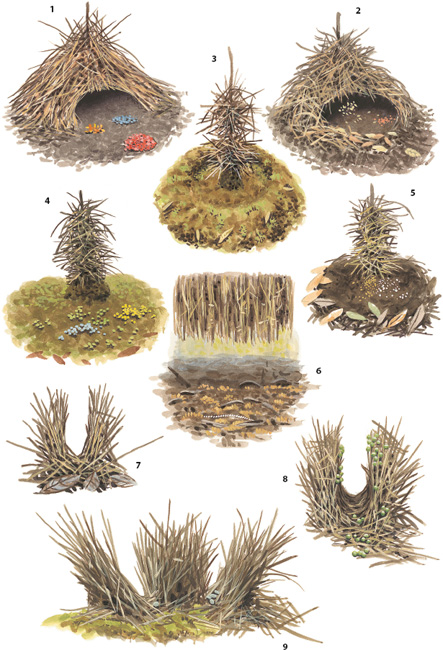
PLATE 68 FAIRYWRENS

|
1 White-shouldered Fairywren Malurus alboscapulatus
10–13 cm. Grasslands and low shrubby thickets. Common and widespread. Male jet black with white shoulder patch. Female color varies geographically. All differ from Male in white partial eye-ring or brow, and black Females have brownish wings. Juv similar to Imm, but duller. Imm more similar to Female, but all-black subspp have some white on chin and abdomen. Subspp groups shown: alboscapulatus (NG, except for next) Female black, locally with white below; lorentzi (Trans-Fly, S Lowlands, southern W Ranges) Female brown. |
Pl. 105, p. 402 |

|
2 Emperor Fairywren Malurus cyanocephalus
13–16 cm. Thickets in abandoned gardens and at lowland forest edge. Common. Male intense dark blue. Female boldly patterned with blue-black head. Juv similar to Female, but duller; head dusky black, not blue. |
p. 402 |

|
3 Wallace’s Fairywren Sipodotus wallacii
11–12 cm. Hill forest. Uncommon. Holds its body horizontal, tail not cocked. A tiny, uniquely patterned warbler-like bird with all-white underparts and wing bars. Throat white in Male, buff-white in Female. Juv duller; crown dark grey and spotted buff; wing bars buff. |
p. 401 |

|
4 Broad-billed Fairywren Chenorhamphus grayi
12–14 cm. Fond of small patches of regrowth appearing after tree falls and landslides within primary forest of hills and nearby lowlands. Rare. Note soft blue color. Differs from Campbell’s FW in Male’s mottled, blue crown, and blue mantle in both sexes. Belly blue in Male, white in Female. Juv, brown feathering in the crown and underparts. |
p. 401 |

|
5 Campbell’s Fairywren Chenorhamphus campbelli
11–12 cm. Replaces Broad-billed FW in S Lowlands. Distinguished from that species by smaller size, crown black in both sexes, and mantle brown. Sexes alike. |
p. 402 |

|
6 Orange-crowned Fairywren Clytomyias insignis
14–16 cm. Cloud forest thickets. Rare. Unique orange-rufous cap. Juv duller and darker, ochre-brown, yet with brownish-orange cap. |
p. 401 |
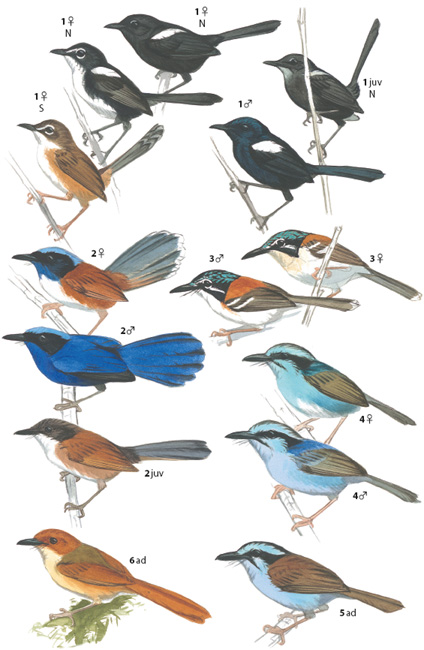
PLATE 69 HONEYEATERS—MYZOMELAS

|
1 Elfin Myzomela Myzomela adolphinae
9 cm. Mid-mountain forest canopy and highland towns. Common. Smallest myzomela. Bill short, decurved. Male red-headed. Female and Juv have pink chin, but not forehead. |
p. 405 |

|
2 Red-headed Myzomela Myzomela erythrocephala
11–12 cm. Mangroves of S NG only. Locally common. Larger than Elfin M, but plumage similar. Subspp shown: infuscata (S NG and Aru Is), darker than nominate race (SE Pen). |
p. 405 |

|
3 Red Myzomela Myzomela cruentata
10–11 cm. Hill and mid-mountain forest canopy, less frequent in lowlands. Male uniquely all red. Female, look for red in tail. Juv male similar, but may have reddish wash above. |
p. 404 |

|
4 Red-collared Myzomela Myzomela rosenbergii
11–12 cm. Cloud forest. Male unique. Female mottled brown, with black face and red breast and rump. Juv mottled brown all over, lacking red and black. Subspp shown: rosenbergii (NG mainland) Female brownish with black face; longirostris (SE Is: Goodenough) longer bill; Female paler, greener, red collar. |
p. 403 |

|
5 Sclater’s Myzomela Myzomela sclateri
11–12 cm. Only on Karkar I, off Sepik-Ramu coast, where it is the only myzomela. Mostly in mountains. Male red-throated. Female and Juv have streaked throat, red chin-spot. |
p. 405 |

|
6 Papuan Black Myzomela Myzomela nigrita
12–13 cm. Hill and lower montane forest canopy; also Trans-Fly woodland. Male black with white underwing-coverts (compare with Black Sunbird, Plate 79). Female with reddish forehead and throat, but not tail. In SE, many Females are all black, duller than Male. Juv resembles grey-brown Female or is darker. Subspp groups shown: nigrita (NG and Aru Is) Male all black; forbesi (SE Is: D’Entrecasteaux) Male has red cap. |
p. 404 |

|
7 Ruby-throated Myzomela Myzomela eques
14–15 cm. Lowland and hill forest and edge. Uncommon. Large and dark with red throat-stripe. Male larger, more red on throat. Juv duller. Subspp shown: primitiva (N NG). |
p. 404 |

|
8 White-chinned Myzomela Myzomela albigula
13–14 cm. The drab, grey-brown myzomela of select SE Is. Common in all wooded habitats. Male larger, exhibits more distinct, red throat-streak (hard to see). Subspp shown: pallidior (small islands only) white throat present in both sexes; albigula (Rossel I) darker and with white throat patch missing in Male. |
p. 403 |

|
9 Dusky Myzomela Myzomela obscura
13–14 cm. The common, drab, coastal myzomela. Male larger, more greyish. Subspp shown: fumata (NG and Aru Is) grey-brown; rubrobrunnea (Biak I) washed with red. |
p. 404 |
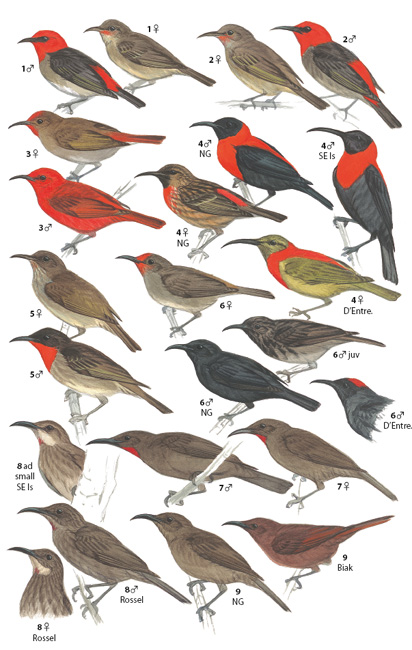
PLATE 70 HONEYEATERS—STRAIGHTBILLS AND STREAKED HONEYEATERS
|
1 Little Shrikethrush Colluricincla m. megarhyncha
For comparison. More likely seen than Tawny Straightbill. Note robust bill and dark leg color. |
Pl. 85, p. 450 |

|
2 Tawny Straightbill Timeliopsis griseigula
18 cm. Rare in lowland forest. Met in mixed-species flocks of other rusty brown birds. Climbs and searches dead leaves. Note short, straight, pointed bill; bright iris; and pinkish grey legs. Adult iris reddish. Male larger. Juv iris grey or dark brown. |
p. 414 |

|
3 Olive Straightbill Timeliopsis fulvigula
13–14 cm. Mid-mountain forest and lower cloud forest. Uncommon. Scolding call. Warbler-like, with green wing edgings and a sharp, straight bill. Adult eye orange; Juv’s grey or brown. |
p. 414 |

|
4 Green-backed Honeyeater Glycichaera fallax
10–12 cm. Lowland and hill forest canopy and midstory, often seen at forest edge. Uncommon. Warbler-like, with straight bill. Petite and nondescript but for whitish iris and narrow pale eye-ring. Male larger. Juv iris brown. Subspp shown: pallida (NW Is: Batanta, Salawati, and Waigeo) paler and greyish; fallax (rest of range) greener and underparts pale yellow. |
p. 405 |

|
5 Grey-streaked Honeyeater Ptiloprora perstriata
19–20 cm. Cloud forest and subalpine. A big, dark, boldly streaked Ptiloprora with no rufous on back. Adult iris green. Male larger. Juv with greenish wash below, iris brown. |
p. 407 |

|
6 Mayr’s Streaked Honeyeater Ptiloprora mayri
19–20 cm. Restricted to several N coastal ranges: Bewani, Cyclops, and Foja Mts. Inhabits cloud forest. Larger and duller than Rufous-backed H. |
p. 407 |

|
7 Rufous-backed Honeyeater Ptiloprora guisei
16–18 cm. Cloud forest. Abundant. Rufous mantle diagnostic. Adult has clear, grey streaking below; iris bright green. Male larger. Juv duller, greenish tint on breast, dull iris. |
p. 407 |

|
8 Rufous-sided Honeyeater Ptiloprora erythropleura
16–17 cm. Western Ptiloprora of mid-mountain and cloud forest. Uncommon. Russet flanks, all-grey back, and reddish iris. Some birds with green iris. Male larger. |
p. 406 |

|
9 Yellow-streaked Honeyeater Ptiloprora meekiana
16–17 cm. Patchily distributed and rare in cloud forest. A medium-sized, yellowish-streaked honeyeater. Male larger. Iris pale grey. |
p. 406 |

|
10 Leaden Honeyeater Ptiloprora plumbea
14–15 cm. Patchily distributed and rare. Mid-mountain forest. A small grey bird with a thin, slightly curved bill, and a silver-grey iris. Male larger. |
p. 406 |
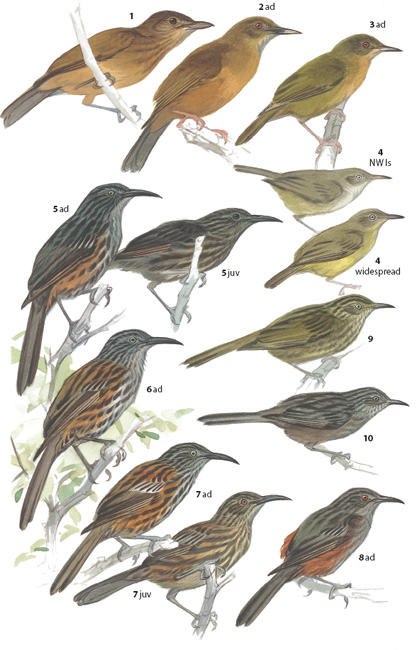
PLATE 71 HONEYEATERS—FRIARBIRDS AND OTHER LARGE, BROWN HONEYEATERS

|
1 Plain Honeyeater Pycnopygius ixoides
18 cm. Forest and edge from lowlands to mid-mountains. Locally common. Uniquely lacks any conclusive field characters. Note small head, small bill, and upright posture. Male larger. Compare with Tawny H. Subspp groups shown: finschi (SE Pen, east of Kumusi R in N and Port Moresby in S) variably rufous brown; ixoides (most of range, except that of previous race) brown. |
p. 407 |

|
2 Marbled Honeyeater Pycnopygius cinereus
22–23 cm. Mid-mountains, in oak forests and second growth. Uncommon. Short bill, unique white crescent below the eye, and white cheek-stripe. Adult has greenish edges to wing and tail feathers; in Juv these tinged brown. Male larger. Subspp shown: cinereus (Bird’s Head to Weyland Mts of W Ranges) faint scaling below; marmoratus (most of range, exclusive of previous) pronounced scaling on breast. |
p. 408 |

|
3 Streak-headed Honeyeater Pycnopygius stictocephalus
20–22 cm. Lowland forest edge and gardens. Sings loudly from high, open perch. Uncommon. Smaller than a friarbird; much smaller bill. Adult shows diagnostic white cheek-stripe and speckled crown. Male larger. Juv shows only indistinct white cheek-stripe. |
p. 408 |

|
4 Long-billed Honeyeater Melilestes megarhynchus
22–23 cm. Forest interior from lowlands to mid-mountains. Common but furtive. Note long, curved bill. Adult has plain, dark underparts and orange eye. Male larger. Juv has paler, streaky breast (variable) and pale eye-ring. |
p. 413 |

|
5 Brass’s Friarbird Philemon brassi
21–22 cm. NW Lowlands. Found locally along rivers and associated lagoons, in dense, second-growth trees and cane grass. Much paler below than Meyer’s F. Whitish chin, black face, dark grey neck. Imm has white scaling on back and wings. |
p. 410 |

|
6 Little Friarbird Philemon citreogularis
24–25 cm. Savannah and monsoon forests of Trans-Fly. Common. Smallest of the 3 savannah friarbirds. Lacking bill knob. White upper throat, blue-grey skin on the face. Male larger. Imm with throat and sides of breast yellow-tinged. |
p. 410 |

|
7 Helmeted Friarbird Philemon buceroides
33–35 cm. A conspicuous bird of towns, gardens, savannah, and forest edge from the lowlands into the mid-mountains. Pugnacious habits and raucous calls. Adult plain grey-brown. Male larger. Imm upperparts pale-scalloped. Subspp groups shown: jobiensis (NW Lowlands and Yapen I to Huon) bill-knob small or missing; novaeguineae (remainder of range, mainly southern) prominent bill-knob. |
p. 411 |

|
8 Noisy Friarbird Philemon corniculatus
30 cm. Trans-Fly savannah. Common. Unique bald, black head and neck ruff. White tail tip. Male larger. Juv head partly feathered. Imm has white-scaled wings and back. |
p. 411 |

|
9 Meyer’s Friarbird Philemon meyeri
21–22 cm. Lowland and hill forests and openings. Uncommon. Plain, dark, sooty brown. Note the long, pointed, slightly decurved bill. Juv upperparts scaled whitish, underparts tinged yellow. Imm like Adult but for bronzy yellow wash across upper breast. |
p. 410 |
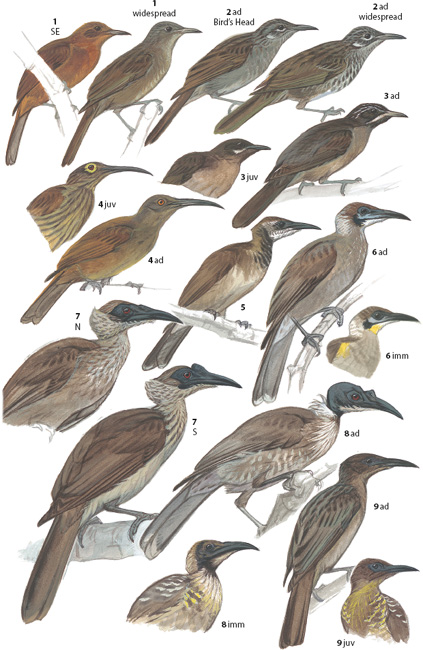
PLATE 72 HONEYEATERS—OF GARDENS AND OPEN COUNTRY

|
1 Tawny-breasted Honeyeater Xanthotis flaviventer
18–21 cm. Forests and second growth from lowlands to mid-mountains. Common. Distinctive shape—a medium-sized, robust honeyeater with medium-long bill. Bare eye and a small, flamelike ear-stripe. Male larger. Subspp groups shown: GREEN GROUP, fusciventris (NW Is) and race flaviventer (Bird’s Head) intermediate; TAWNY GROUP, visi (Bird’s Neck, S Lowlands, SE Pen) tawny brown, grey throat; DUSKY GROUP, meyeri (NW Lowlands to Sepik-Ramu) dark grey brown, dark eye-skin; SPOTTED GROUP, spilogaster (SE Is: D’Entrecasteaux) spotted below, spectacled. |
p. 409 |

|
2 Yellow-tinted Honeyeater Ptilotula flavescens
12–13 cm. Only in SE. Eucalypt savannahs and nearby town gardens, where locally common. A small, pale, yellowish honeyeater with black-and-gold ear-stripe. Dark eye set against yellow face. Adult bill all black, Juv bill pale with dark tip. Male larger. |
p. 419 |

|
3 Rufous-banded Honeyeater Conopophila albogularis
13 cm. Open habitats near coast and rivers, including towns, roadsides. Locally common. Small. Adult has pale rufous breast band, white throat, grey hood. Male larger. Juv, note whitish throat, may have an eye-ring. |
p. 414 |

|
4 Brown-backed Honeyeater Ramsayornis modestus
11 cm. Another coastal species, common near water in open habitats; in some towns. No other has white throat and dark barring or pinkish bill and legs. Juv streaky below. |
p. 415 |

|
5 Silver-eared Honeyeater Lichmera alboauricularis
15–16 cm. Open coastal and riverine habitats. Gregarious and noisy. Like a small, grey-brown meliphaga with silvery ear-spot and dark-spotted pale breast. Male larger. Juv, obscure ventral spotting and ear-spot. |
p. 409 |

|
6 Brown Honeyeater Lichmera indistincta
13–14 cm. Savannah and other open, wooded, lowland habitats near water. Locally common. Loud, cheery song. Small yellow spot behind eye and yellow-green edges of wings and tail. Gape line yellow, becoming black in breeding male. Male larger, with greyish crown. Juv head tinged yellowish, eye-spot absent. See Dusky Myzomela (plate 69). |
p. 408 |
|
7 Olive Honeyeater Lichmera argentauris
14–15 cm. NW Is. Small, meliphaga-like. White-and-yellow ear-spot. Male larger. |
p. 408 |

|
8 White-throated Honeyeater Melithreptus albogularis
12–13 cm. Savannah, in eucalyptus and paperbark trees. Common, noisy, gregarious. Unmistakable. Male larger. |
p. 412 |

|
9 Blue-faced Honeyeater Entomyzon cyanotis
30 cm. Trans-Fly savannah. Common. Unmistakable. Wings flashing white while flying. Adult has bright blue face patch, Imm yellowish-green patch. Male larger. |
p. 411 |
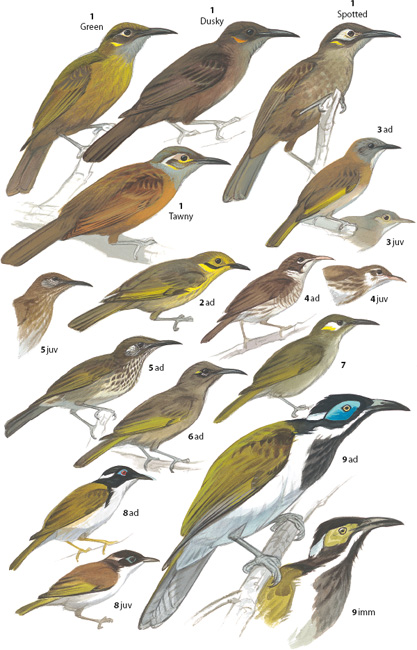
PLATE 73 HONEYEATERS—VARIOUS GREEN, SMOKY, AND GIANT HONEYEATERS

|
1 Spotted Honeyeater Xanthotis polygrammus
16–17 cm. Canopy dweller in hill and lower montane forests; also monsoon forest and well-wooded savannah in Trans-Fly. Uncommon. Profusely dark-spotted below. Big, dark eye; colorful, bare eye-ring; yellow ear-streak (most races). Male larger. Juv duller. |
p. 409 |

|
2 Obscure Honeyeater Caligavis obscura
18–19 cm. In hill forest and adjacent lowlands. Uncommon and unobtrusive, though vocal. Resembles a meliphaga, but the face is more colorful. Diagnostic bicolored ear-spot and yellow-washed throat. Male larger. Juv, brownish rump. |
p. 415 |

|
3 Black-throated Honeyeater Caligavis subfrenata
20–21 cm. Cloud forests and subalpine shrubbery. Uncommon, except in flowering trees and shrubs. Vocal and active. Looks like a miniature melidectes; however, the bicolored (yellow/white) ear-spot and orange legs are diagnostic. Male larger. |
p. 415 |

|
4 Orange-cheeked Honeyeater Oreornis chrysogenys
24–26 cm. Timberline forest and shrubbery on highest peaks of W Ranges. Locally common. Distinctive. A big, olive-green honeyeater with orange cheek patch and yellowish legs. Male larger. |
p. 416 |

|
5 Varied Honeyeater Gavicalis versicolor
19–22 cm. Strictly coastal. Strand forests, mangroves, small islands, and many seaside towns. Common but shy. A familiar, melodious voice. Adult has streaky underparts, black mask, and yellow-and-white ear-patch. Male larger. Juv paler, duller. Subspp shown: sonoroides (N coast of NG, NW Is, SE Is) green above, strong yellow wash below; versicolor (S coast) grey and green above, whitish below. |
p. 418 |

|
6 Spangled Honeyeater Melipotes ater
31–32 cm. Huon mountains. Common. Size of bird of paradise. Long tail. White spots on breast. |
p. 413 |

|
7 Common Smoky Honeyeater Melipotes fumigatus
21–22 cm. The widespread smoky honeyeater. Common in montane forest. Yellow facial skin can flush red. From other SHs by the grey chin and grey-edged breast feathers. Male larger. Subspp shown: fumigatus (all range except that of next race) typical for the species, size varies. Not shown is kumawa (Kumawa Mts) wings white-spotted, breast white-scalloped. |
p. 413 |

|
8 Wattled Smoky Honeyeater Melipotes carolae
21–22 cm. Foja Mts. Common. Pendent wattle below the eye and dark chin. |
p. 413 |
|
9 Western Smoky Honeyeater Melipotes gymnops
21–22 cm. Bird’s Head. Montane forest, edge. Abundant. Black chin and white streaking below. |
p. 412 |

|
10 Giant Wattled Honeyeater Macgregoria pulchra
38–40 cm. Highest mountains, though patchily distributed. Inhabits alpine forest and shrubland at timberline. Unmistakable. Noisy wings aid detection. Adult iris red-brown. Male larger, with bigger wattle. Juv duller; iris brown. Subsp pulchra (SE Pen) shown. |
p. 412 |
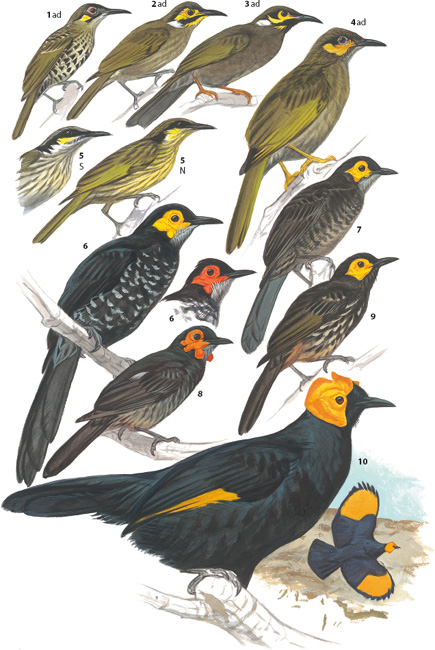
PLATE 74 HONEYEATERS—MELIDECTES AND SOOTY HONEYEATERS

|
1 Ornate Melidectes Melidectes torquatus
22–23 cm. Mid-mountain forests, disturbed areas with trees, and highland towns. Common. A medium-sized, colorful melidectes with banded throat and breast. Yellow-orange eye-skin and buffy breast. Male larger. Juv duller. Subspp groups shown: emilii (SE Pen) small white throat patch, throat wattles large; torquatus (rest of range) large white throat patch, throat wattles small or absent. |
p. 417 |

|
2 Sooty Honeyeater Melionyx fuscus
23–24 cm. High mountain cloud forest and shrubland. Common in the East, rare in the West. A slender, sooty black honeyeater with a white, tear-shaped eye wattle and thin black bill. Forages with tail cocked. Adult black. Male larger. Juv browner. |
p. 416 |

|
3 Long-bearded Honeyeater Melionyx princeps
26–27 cm. Cloud forest at timberline and shrubbery in alpine grassland. Common away from people. Unusually long, slim bill and conspicuous, wispy “beard.” Beard white in Adult, yellowish in Juv. Male larger. |
p. 416 |
|
4 Short-bearded Honeyeater Melionyx nouhuysi
27–28 cm. The western counterpart of the Long-bearded H. Larger. Shorter bill and beard. |
p. 416 |

|
5 Vogelkop Melidectes Melidectes leucostephes
26 cm. The large, blackish melidectes of Bird’s Head and Neck. Mid-mountain forest and edge. White-spotted breast and exaggerated white facial markings. |
p. 417 |

|
6 Huon Melidectes Melidectes foersteri
28–29 cm. The large melidectes of Huon mountains. Largest of all melidectes. Blue eye-skin, white brow and ear-stripe, and unique red gape wattles. |
p. 417 |

|
7 Cinnamon-browed Melidectes Melidectes ochromelas
24–25 cm. Occupies mid-mountain forest and edge. Locally common. A medium-size, dark melidectes with pale greenish-yellow orbital skin. Lacks a white throat-stripe, so the ruby-red throat wattles stand out alone against the dark throat. Male larger. |
p. 417 |

|
8 Belford’s Melidectes Melidectes belfordi
27–28 cm. The cloud forest melidectes of the Central Ranges, living at mostly higher elevations than Yellow-browed M, but locally hybridizing with it. Common, noisy, and conspicuous. “Pure” Belford’s distinguished by the blackish bill and legs, black forehead, white brow and ear-streak, blue eye-skin, and absence of throat wattles. Male larger. Juv similar to Adult but blacker, with reduced white facial markings. |
p. 418 |

|
9 Yellow-browed Melidectes Melidectes rufocrissalis
26–27 cm. The large, mid-mountain melidectes of the E and Border Ranges. Locally common. Originally a forest bird, but now most often seen in casuarina groves and other man-made habitats of intermontane valleys, below the forested ridges and peaks occupied by Belford’s. Hybridizes with Belford’s M, so identification often not possible. “Pure” Yellow-browed has pearly grey bill and legs; white forehead; yellow brow and ear-streak; extensive, pale, greenish-yellow facial skin; and presence of a large, pale gape wattle and a pair of red throat wattles. |
p. 418 |
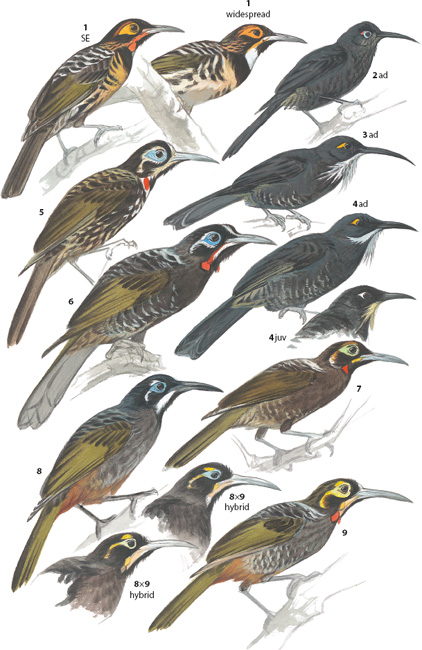
PLATE 75 HONEYEATERS—THE MIMIC MELIPHAGAS

|
1 Elegant Meliphaga Meliphaga cinereifrons
14–16 cm. Lowland and hill forests, particularly second growth, edge, and other open wooded habitats and mangroves. Small. Dark sides of face; often blackish hind edge of yellow ear-spot. Ear-spot large and round, often with a projection reaching upward behind the eye. Underwing-coverts ochraceous. Subsp shown is cinereifrons (S watershed) shown. |
p. 420 |
|
2 Graceful Meliphaga Meliphaga gracilis
14–16 cm. Lowland forests of all types; predominantly in second growth, edge, mangroves, swamp forest, and savannah. Resembles Mimic M, but smaller with more slender bill. Underwing pale yellowish to white without ochraceous wash. |
p. 421 |

|
3 Mimic Meliphaga Meliphaga analoga
16–19 cm. The standard meliphaga—ordinary in plumage and shape, present nearly everywhere in lowland and hill forests of all sorts, easy to observe. Medium to large size; long slender bill. Greenish upperparts; unmottled underparts. Ear-spot yellow, large, and elongate. Sides of head not so dark. Shown are former subspp flavida (NW Lowlands, Sepik-Ramu) and analoga (rest of range). |
p. 421 |

|
4 Puff-backed Meliphaga Meliphaga aruensis
16–18 cm. Lowland and hill forest and edge; common in midstory and understory. Large, chunky, stout-billed. Diagnostic thick rump-tuft shows white fringe on the side, but usually hidden under the wing. Variation shown. |
p. 419 |

|
5 Mountain Meliphaga Meliphaga orientalis
14–16 cm. Mid-mountain forests, where usually the only meliphaga. Small, with a slender bill. Variable—best identified by habitat and size. Subspp shown: facialis (species range exclusive of next 2 races) less dusky face, reduced mottling; orientalis (eastern SE Pen) dark sides of face, coarse-textured below; citreola (N slopes of W Ranges to N Coastal Mts) face green, underparts yellower. |
p. 421 |

|
6 White-eared Meliphaga Meliphaga montana
16–17 cm. Hill forests of the North. Common in forest interior. Adult has unique combination of brown plumage and white ear-spot. Note mottling of underparts. Juv also brown, but ear-spot pale yellow. Extremes from Bird’s Head and Bantana I shown. |
p. 420 |

|
7 Scrub Meliphaga Meliphaga albonotata
16–17 cm. A scrub and garden specialist. Numerous in mountains, less so in lowlands. Adult is the only green meliphaga with white ear-spot (rictal streak obscure); underparts lack mottling. Juv has pale yellow ear-spot. |
p. 422 |

|
8 Mottled Meliphaga Meliphaga mimikae
16–18 cm. Southern, yellow-eared counterpart of White-eared M. Look for mottled breast, more heavily marked than any other meliphaga. Narrow, pale eye-ring. |
p. 420 |

|
9 Yellow-gaped Meliphaga Meliphaga flavirictus
15–16 cm. Least common of the meliphagas. Lowland and hill forest canopy. Prominent bright yellow rictal streak and a small, pale yellow ear-spot (colors reversed in the very similar Mimic M); face not dusky; diagnostic yellowish-olive legs in S race. A rather pale species with smooth-textured underparts. Subspp shown: crockettorum (W and N NG) darker and brighter yellow-green, legs greyish; flavirictus (Trans-Fly to SE Pen) paler, legs yellowish olive, ear-spot palest yellow. |
p. 420 |

|
10 Tagula Meliphaga Meliphaga vicina
17–18 cm. Tagula I (SE Is) endemic. Common in all forests and disturbed habitats. Large size; long, heavy bill. Closest to Mimic M, except has ochraceous underwing-coverts. |
p. 422 |
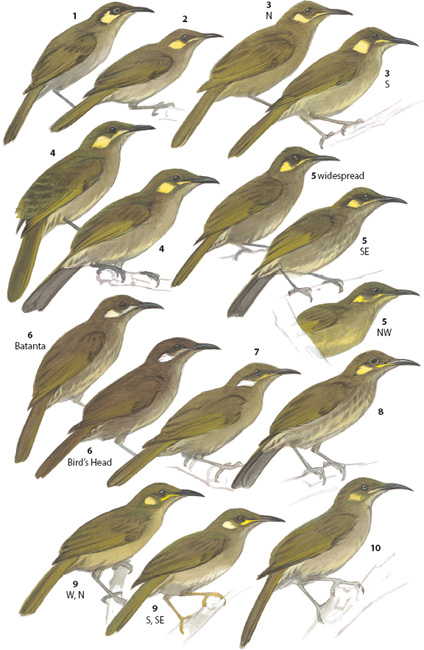
PLATE 76 SCRUBWRENS

|
1 Buff-faced Scrubwren Sericornis perspicillatus
10 cm. Montane forest. Common. Buff face set with a dark, beady eye and capped by a contrasting greyish crown. |
p. 425 |

|
2 Vogelkop Scrubwren Sericornis rufescens
9–10 cm. Endemic to the Bird’s Head mts. Pronounced buff eye-ring. |
p. 425 |

|
3 New Guinea Thornbill Acanthiza murina
9–10 cm. Subalpine forest. Common. Diagnostic whitish iris and grizzled cheek. Dingy white underparts and short tail with a dark subterminal bar contrasting with pale tip. |
p. 426 |

|
4 Large Scrubwren Sericornis nouhuysi
12–14 cm. The large, common scrubwren of montane forest. Olive-or rufous-brown with a contrast between the upperparts and underparts, especially evident at the eye-line. Lacks dark subterminal tail-band. Compare with Papuan S. Subspp shown: nouhuysi (W Ranges) more rufous brown; oorti (Huon, SE Pen) more olive above and yellowish below; cantans (Bird’s Head) similar in wing markings to Tropical S. |
p. 425 |

|
5 Tropical Scrubwren Sericornis beccarii
10–13 cm. Lowland and hill forest. Locally common. Usually more olive than Large S, and shows white tips to wing-coverts and usually a broken white eye-ring. The subspp show a confusing geographic pattern and appear to be the result of hybridization with Large S. Subspp groups shown:
“PERPLEXING GROUP 1” tends toward Large S (shown is virgatus of N Coastal Range);
“PERPLEXING GROUP 2” tends toward typical Tropical (shown are idenburgi of N slope of W Ranges and wondiwoi of Wandammen Mts);
“TYPICAL TROPICAL” olive and brightly patterned (shown is randi of S Lowlands). |
p. 424 |

|
6 Papuan Scrubwren Sericornis papuensis
10–11 cm. Cloud forest, mainly at higher elevations than Buff-faced S. Common. From Large S: smaller, with buffy orange eye-ring and forehead band. Unique pale spot at the base of the primaries. Dark subterminal tail-band. Juv olive green. Subspp shown: papuensis (SE Pen) olive brown (meeki of W Ranges is similar); buergersi (E Ranges) brown. |
p. 426 |

|
7 Grey-green Scrubwren Sericornis arfakianus
9–10 cm. Lower montane forest. Elevational range narrow, fits between Pale-billed S below and Buff-faced S above. Common. A small, grey-green scrubwren. Juv slightly more brownish. Shown is variation in the degree of streaking below. |
p. 426 |

|
8 Pale-billed Scrubwren Sericornis spilodera
10–12 cm. Hill forest and locally in lowlands. Common. Pale bill diagnostic. Usually greenish with dark-spotted pale throat (spots lacking in Juv). Clinal variation. Subspp shown: spilodera (N NG from Bird’s Head to Sepik-Ramu) dark and strongly marked; guttatus (SE Pen) green crown; aruensis (Aru Is) very pale, without spotting. Not shown: ferrugineus (NW Is, rufous crown) and granti (S Lowlands, green crown). |
p. 424 |
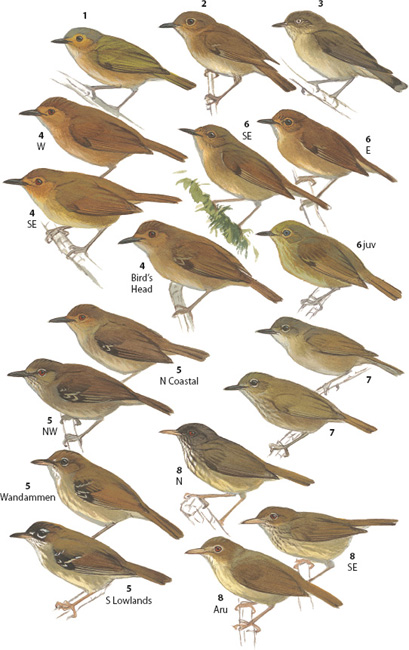
PLATE 77 GERYGONES

|
1 Grey Thornbill Acanthiza cinerea
9 cm. Cloud forest. Uncommon. All plumages grey above, white below. Iris brown. |
p. 426 |

|
2 Large-billed Gerygone Gerygone magnirostris
10 cm. Lowland forests along streams, rivers, and swamps in mainland NG; in forest away from water on islands. Common. Rather plain. Note broken eye-ring and sometimes a loral spot; red iris. Juv throat yellowish; brown iris. Subspp groups shown: magnirostris (all NG Region except next) underparts variable whitish to pale buffy; hypoxantha (NW Is: Biak) underparts washed pale yellow. |
p. 428 |

|
3 Brown-breasted Gerygone Gerygone ruficollis
9–10 cm. Mountains. Common in highland villages and second growth with tall trees; less common in forest. Adult brown above, whitish below; white band in outer tail feathers; silver-edged tertials; red iris. Juv with yellowish underparts, brown iris. |
p. 428 |

|
4 Yellow-bellied Gerygone Gerygone chrysogaster
10 cm. Lowland forest interior. Common. Adult with two-toned underparts: white breast, yellow flanks. Contrasting brown tail. Juv ear-coverts greyer. Subspp groups shown: chrysogaster (most of range except next) upperparts olive, breast white, bill dark; notata (Bird’s Head; NW Is of Salawati and Misool) upperparts greener, bill pale; neglecta (NW Is: Waigeo and Batanta) breast and belly with yellow wash, bill pale. |
p. 427 |

|
5 Mangrove Gerygone Gerygone levigaster
9–10 cm. Mangrove specialist of S NG; uncommon. Adult with white eyebrow and cheeks. Juv has a yellowish eyebrow and throat; iris brown. |
p. 428 |

|
6 Green-backed Gerygone Gerygone chloronota
8–9 cm. Lowland and hill forest canopy and edge. Locally common. Often heard, rarely seen. Tiny, short-tailed, stubby. Adult with distinctive 3-colored pattern: white underparts, grey head, and green back. No eye-ring. Juv duller, has broken eye-ring. |
Pl. 105, p. 427 |

|
7 Fairy Gerygone Gerygone palpebrosa
10 cm. Common in forest of foothills and lower mountains, less so lowlands. Male, unique. Female green above, yellow below with white throat and loral spot. Juv similar but underparts all yellowish. Subspp shown: wahnesi (N NG, from NW Lowlands to SE Pen), Male has black crown, nape. palpebrosa (S NG, from NW Is to SE Pen), Male has green crown, nape. |
p. 428 |

|
8 White-throated Gerygone Gerygone olivacea
9–10 cm. Savannahs of Port Moresby region. Adult brown above, yellow below with white throat and loral spot. Juv entirely pale yellow below; note pale eyebrow. |
p. 427 |
|
9 Island Leaf-Warbler Phylloscopus poliocephalus
9–10 cm. For comparison. Strong eyebrow and crown-stripes. |
Pl. 105, p. 497 |
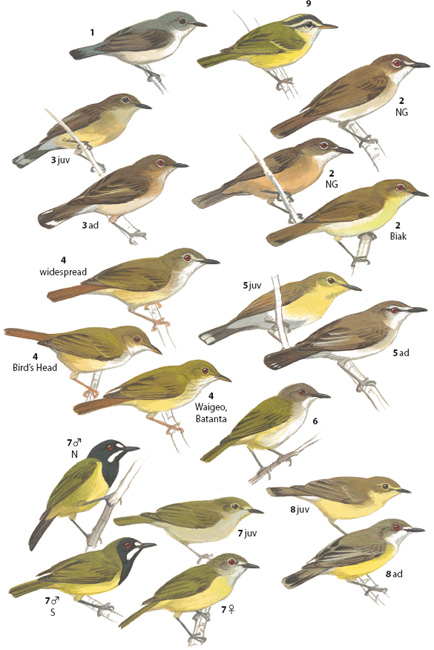
PLATE 78 BERRYPECKERS AND PAINTED BERRYPECKERS

|
1 Spotted Berrypecker Rhamphocharis crassirostris
11–12 cm. Rare in mid-mountain forest. Bill long and straight. Female spotted. Subspp groups shown: crassirostris (Bird’s Head to Border Ranges) much shorter bill; dark ventral spotting; piperata (E Ranges to SE Pen and Huon) longer bill; white ventral spotting. |
p. 433 |

|
2 Black Berrypecker Melanocharis nigra
11–12 cm. The common berrypecker of lowland and hill forest. Note white pectoral tuft (yellow in N Huon). Female and Juv green with white pectoral tuft. Subspp groups shown: nigra (NW Islands, Bird’s Head and Neck) Male black above, grey below; chloroptera (S Lowlands and Aru Is) Male similar, but has green wing; unicolor (NW Lowlands to SE Pen) Male all black. |
p. 432 |

|
3 Obscure Berrypecker Melanocharis arfakiana
11–12 cm. Rare in hill forest. Both sexes similar to female Black BP. Identify by prominent orange gape and tan-horn bill color. Pectoral tufts lemon yellow. Head grey. |
p. 432 |

|
4 Mid-mountain Berrypecker Melanocharis longicauda
13 cm. The common berrypecker of mid-mountain forest. Tail longer than that of Black Berrypecker. Note yellow pectoral tuft and yellow wash on belly. Male black above. Female and Juv green above. |
p. 433 |

|
5 Streaked Berrypecker Melanocharis striativentris
13–14 cm. Usually rare in mid-mountain forest. All plumages show streaky breast, broad buff eye-ring, and orange gape. Female and Juv with longer tail than Male. |
p. 433 |

|
6 Fan-tailed Berrypecker Melanocharis versteri
14–15 cm. Common in cloud forest. Note long, graduated tail. Male metallic blue-black above, grey below. Female and Juv green above with white pectoral tuft and yellow gape. |
p. 433 |

|
7 Tit Berrypecker Oreocharis arfaki
12–14 cm. Montane forests. Male unique. Female and Juv have a diagnostic combination of green upperparts, grey throat, and dark-scalloped yellowish flanks. Note yellow wing spots. |
p. 435 |

|
8 Eastern Crested Berrypecker Paramythia montium
20–22 cm. High cloud forest and subalpine shrubland. Adult with distinctive black mask, drooping crest, and long white eyebrow with greyish cast. Blue and yellow underparts. Juv duller with obscured pattern and blue restricted to side of neck. Nominate subspecies shown. |
p. 435 |
|
9 Western Crested Berrypecker Paramythia olivacea
20–22 cm. Differs by upcurved crest; short, all-white eyebrow; and olive (vs bright green of Eastern CB) back. |
p. 435 |
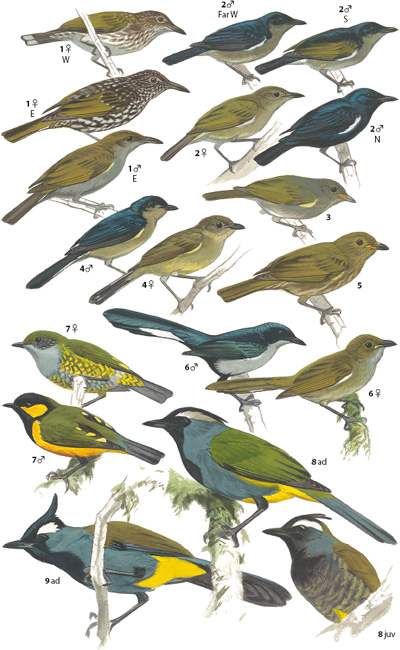
PLATE 79 SUNBIRDS, LONGBILLS, AND FLOWERPECKERS

|
1 Black Sunbird Leptocoma aspasia
11–12 cm. Common in forest and edge in lowlands, less common in hills. Male jet black with blue and green flashes (unlike Papuan Black Myzomela). Female has grey hood contrasting with yellowish belly. Juv, head more greenish than Female. |
p. 509 |

|
2 Rand’s Sunbird Cinnyris idenburgi
11 cm. Swampy second growth in river basins. Local, uncommon, and little known. Male has all-black underparts and orange tufts. Female and Juv from Olive-backed S by darker, more brownish back; obscure eyebrow; and greyer, more obscure tail tips. |
p. 509 |

|
3 Olive-backed Sunbird Cinnyris jugularis
11–12 cm. Common in towns, gardens, and forest edge in lowlands and hills. Bright yellow underparts. Male has black throat, yellow breast. Nonbreeding and Imm males with just a black throat-stripe. Female and Juv, prominent yellow eyebrow. |
p. 509 |

|
4 Spectacled Longbill Oedistoma iliolophus
11 cm. Common in lowland to mid-elevation forest. All plumages plain-colored with yellow eye-ring (difficult to see). Subspp groups shown: iliolophus (NG) olive crown; cinerascens (NW Is: Waigeo) grey crown; fergussonis (SE Is: D’Entrecasteaux) like iliolophus but much larger. |
p. 434 |

|
5 Pygmy Longbill Oedistoma pygmaeum
7 cm. Common in canopy of lowland and hill forest. Smallest NG bird. Forages in flocks. All plumages plain, with short tail and slender, decurved bill. Subspp shown: pygmaeum (NG and NW Is) greenish head, yellowish underparts; meeki (SE Is: D’Entrecasteaux Is) larger, with grey head and whitish underparts. |
p. 434 |

|
6 Yellow-bellied Longbill Toxorhamphus novaeguineae
12–13 cm. Common in understory and midstory of lowland and hill forest. Very long bill. All plumages olive green. Subspp shown: novaeguineae (NW Is and Bird’s Head to Sepik-Ramu) olive underparts; flaviventris (S Lowlands) yellow breast and belly. |
p. 434 |

|
7 Slaty-headed Longbill Toxorhamphus poliopterus
13 cm. Montane replacement of Yellow-bellied L. All plumages have a grey head and wings and yellow on lower throat and upper breast. White tail tips flash in flight. |
p. 434 |

|
8 Olive-crowned Flowerpecker Dicaeum pectorale
9 cm. Replaces Red-capped F in the far West. Olive, no red cap or rump. |
p. 508 |

|
9 Red-capped Flowerpecker Dicaeum geelvinkianum
9 cm. The widespread NG flowerpecker. A tiny, stubby bird in forest canopy from lowlands to mid-mountains. Common. Red cap and rump. Male has a red breast. Juv, base of bill red. Subspp groups shown: group geelvinkianum (NG, Bay Is, D’Entrecasteaux Is) olive or with purple-blue gloss; highly variable, e.g., subspp maforense (Bay Is), albopunctatum (Trans-Fly), and rubrocoronatum (Sepik-Ramu to SE Pen). Group nitidum (Louisiade Is, rosseli illustrated) green-blue gloss; yellow-green below. |
p. 508 |

|
10 Mistletoebird Dicaeum hirundinaceum
9 cm. Only flowerpecker on Aru Is. Adults have a red vent. |
p. 509 |
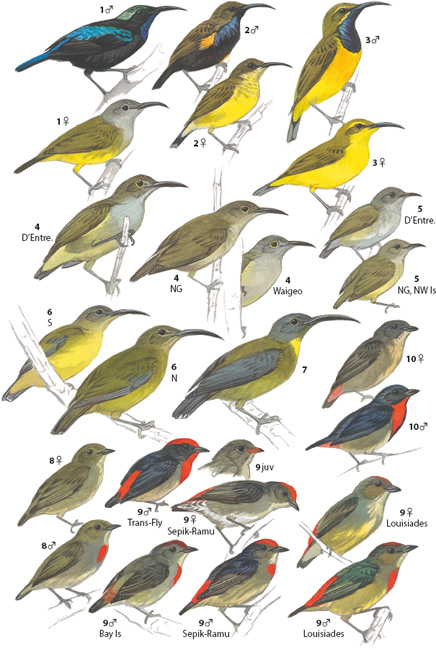
PLATE 80 BUTCHERBIRDS AND ALLIES

|
1 Mountain Peltops Peltops montanus
20 cm. Mountains. In tall trees overlooking a clearing or valley. Common, but patchy. Adult from Lowland P by trilling song and fan-shaped cheek patch extending well above the level of the eye. Juv sooty, more white on face. |
p. 439 |

|
2 Lowland Peltops Peltops blainvillii
18–20 cm. Lowlands and hills. Uncommon, found locally in forest openings. From Mountain P by its clicking song and tear-shaped cheek patch mostly below the level of the eye. |
p. 439 |

|
3 White-breasted Woodswallow Artamus leucorynchus
18 cm. Lowland towns, open habitats, islands, and coasts. Conspicuous and common. Adult has ashy grey head and upperparts and grey hood stops on throat. Juv has pale chin and throat; upperparts with fine pale scalloping. |
p. 441 |

|
4 Great Woodswallow Artamus maximus
20 cm. Mountains, usually common. Adult is a larger, darker version of White-breasted WS. Hood extends down onto breast below the shoulder. White shoulder spot in flight. |
p. 441 |

|
5 Black-faced Woodswallow Artamus cinereus
18 cm. Rare in Trans-Fly savannah. Adult uniformly grey with black face mask and white-tipped, black tail. Juv has back and wings spotted buff. |
p. 441 |

|
6 Hooded Butcherbird Cracticus cassicus
32–35 cm. Lowlands and hills along forest edges and rivers, and in tall second growth. Common. Adult with black head, throat. Juv, black feathers tipped brown, bill darker. Subsp shown: cassicus (NG mainland and western islands). Not shown is hercules (SE Is: D’Entrecasteaux and Trobriand Is) much larger. |
p. 440 |

|
7 Black-backed Butcherbird Cracticus mentalis
25–28 cm. Savannah woodland and nearby towns. Common. White throat in all plumages. Juv has black replaced by messy brown, bill darker. |
p. 440 |
|
8 Tagula Butcherbird Cracticus louisiadensis
27–30 cm. Tagula I (SE Is) only. Uncommon in forest interior and edge. Adult is almost entirely black. Juv similar but duller, the black feathers faintly pale-tipped. |
p. 440 |

|
9 Black Butcherbird Cracticus quoyi
33–36 cm. Lowlands to mid-mountain valleys, in forest interior and mangroves. Uncommon and shy, best located by voice. Adult all black with grey bill. Juv duller, bill darker. |
p. 439 |

|
10 Australian Magpie Cracticus tibicen
41 cm. A crow-sized, stocky, black-and-white songbird of the Trans-Fly savannah; uncommon. Black face and underparts. Male with white back. Female and Imm black above with white nape and rump. Juv like Female, but greyish. |
p. 440 |
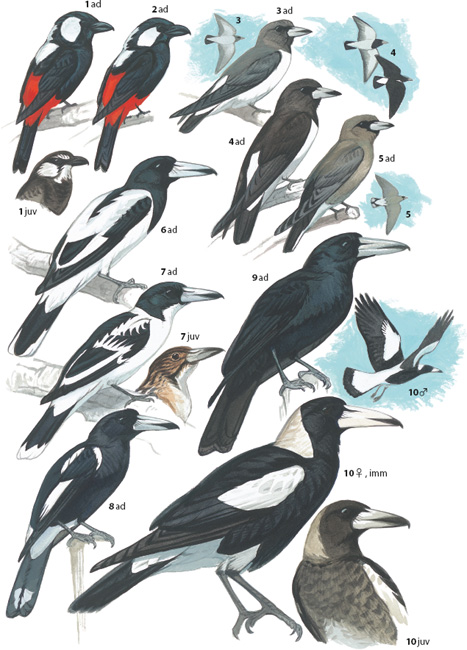
PLATE 81 CUCKOOSHRIKES AND TRILLERS

|
1 Black-browed Triller Lalage atrovirens
18–19 cm. Forests of the North, in lowlands and hills. Common. No white eyebrow. Vent white. Male glossy black, plain white below. Female and Juv duller above and barred below. |
p. 444 |

|
2 Varied Triller Lalage leucomela
18 cm. Forests of the South and Southeast, common in lowlands and hills. White eyebrow. Vent buff or cinnamon. Rump barred. Male boldly patterned, usually barred below. Female duller; underparts all barred. Juv pale-mottled above. Subsp shown is polygrammica (NG except Trans-Fly; also Aru Is). See text for other races. |
p. 445 |

|
3 Biak Triller Lalage leucoptera
18–19 cm. Biak I. Forests and edge. Large white wing patch, and Female not barred below. |
p. 445 |

|
4 White-winged Triller Lalage tricolor
16–18 cm. Savannah and open habitats. Patchy and scarce. Breeding male has large white patch across wing, grey rump. Nonbreeding male like Female, but primaries and tail black, rump grey. Female drab; pale eyebrow, pale edges to wing-coverts and secondaries, and greyish rump. Juv drab, obscurely mottled and scalloped. |
p. 444 |

|
5 Golden Cuckooshrike Campochaera sloetii
20 cm. Foothills and nearby lowlands. Locally common. Orange and black. Male, black face. Female, grey face. Juv yellow face and greenish central tail. Subsp shown: flaviceps (S NG: S Lowlands to SE Pen) crown olive. Not shown is sloetii (N NG: Bird’s Head to Sepik) crown grey. |
p. 444 |

|
6 White-bellied Cuckooshrike Coracina papuensis
25–26 cm. Midsize cuckooshrike of open habitats and towns from lowlands to highland valleys. Common and conspicuous. Adult has thick, black lores with crisp border. Juv has lores less distinct, breast obscurely scalloped. Subspp groups shown: papuensis (N NG: Bird’s Head to Huon) evenly grey; hypoleuca (S NG: S Lowlands to SE Pen, and Aru Is) throat and breast white. |
p. 443 |

|
7 Stout-billed Cuckooshrike Coracina caeruleogrisea
33–37 cm. Large cuckooshrike in lowland to mid-mountain forests. Long, stout bill; long tail. Male black lores. Female all-grey face. Juv partly white or just white-tipped tail. |
p. 442 |

|
8 Black-faced Cuckooshrike Coracina novaehollandiae
32–35 cm. Large, elongate cuckooshrike of open country and towns. Adult’s black throat grades into grey breast. Juv, small black mask. Subsp shown: melanops (breeds Port Moresby area, also austral winter migrant from AU). |
p. 443 |

|
9 Hooded Cuckooshrike Coracina longicauda
33 cm. Large, long-tailed cuckooshrike of cloud forests. Uncommon. In family parties. Male, black hood. Female and Imm, black face. Juv like Female but with messy, white feather edges. |
p. 442 |
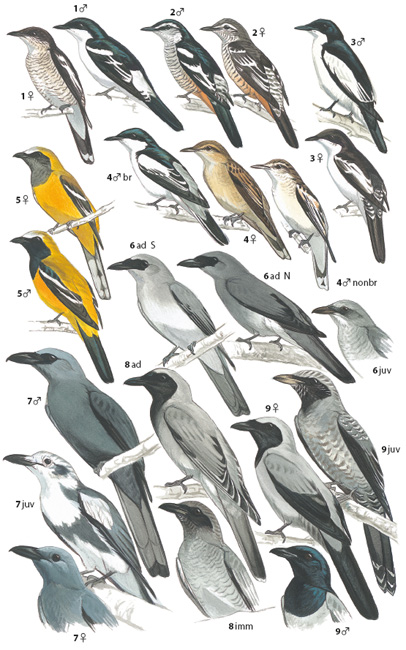
PLATE 82 CUCKOOSHRIKES AND CICADABIRDS

|
1 Barred Cuckooshrike Coracina lineata
23 cm. Hill forest and edge; uncommon. Fig specialist. Note pale eye. Male all grey in common race. Female of all races barred below. Juv like Female but with obscure barring on chin and throat and with white-tipped tail feathers. Subspp shown: axillaris (NG range, exclusive of next two) Male all grey, not barred; maforensis (Numfor I) Male darkly barred below. Not shown is lineata (rare in Trans-Fly, also AU) larger, both sexes barred. |
p. 442 |

|
2 Boyer’s Cuckooshrike Coracina boyeri
22 cm. Lowland forest canopy. Common. Small size, short bill. Pale crown. Male, black lores and chin. Female, pale grey lores. Juv like Female but marked. Subspp shown: boyeri (N NG: NW Is to SE Pen) underwing rufous, Female with pale lores; subalaris (S NG: S Lowlands to SE Pen) underwing buff, Female with plain grey face. |
p. 443 |

|
3 Common Cicadabird Edolisoma tenuirostre
24–27 cm. Lowlands and hill. Forest edge, second growth, savannah; also forest on islands. Uncommon. Compare with the following 2 spp. Common CB larger, more elongate; wing with strongly contrasting silver-grey (not medium grey) edges on wing-coverts and secondaries. Female and Imm drab brown, barred below; black eye-stripe. Juv, brown above; whitish below, streaked brown. Subspp groups shown: tenuirostre (AU migrant) widespread in winter (resident aruense of S NG smaller); rostratum (Rossel I); meyerii (Biak I); numforanum (Numfor I). |
p. 446 |

|
4 Papuan Cicadabird Edolisoma incertum
21–22 cm. Hill and lower montane forest and edge. Common. Male more compact than Common CB, often with darker throat, and wing with poorly contrasting dark grey edges on coverts and secondaries. Female like Male but paler and black only in lores. Juv like Female, but obscurely pale-marked. |
p. 445 |

|
5 Grey-headed Cicadabird Edolisoma schisticeps
21–22 cm. Hills and nearby lowlands. Locally common in forest. Male wing unpatterned grey. Female and Juv rufous, lacking pale eyebrow of female Black CB. Subspp shown: schisticeps (NW Is, Bird’s Head and Neck) Female with grey crown; vittatum (SE Is: D’Entrecasteaux Is) Female underparts barred; reichenowi (NW Lowlands and Sepik-Ramu) Female with all-brown head. Not shown is poliopsa (S Lowlands and SE Pen) Female with all-grey head. |
p. 446 |

|
6 Black-bellied Cicadabird Edolisoma montanum
24 cm. Montane forest. Common. Male grey above, black below. Female and Imm, all-black tail and flight-feathers. Juv, white-edged secondaries and tail tip. |
p. 445 |

|
7 Black Cicadabird Edolisoma melas
23 cm. Lowland and hill forest. Common. Forages below the canopy in mixed-species flocks. Male black. Female and Imm brown or rufous with pale eyebrow. |
p. 447 |
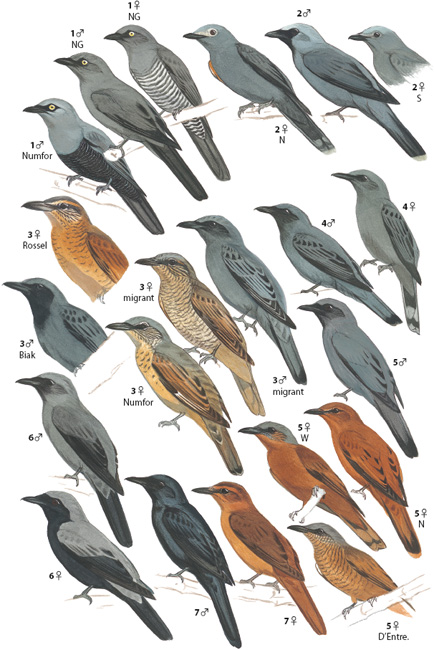
PLATE 83 BIRDS THAT CLIMB AND MISCELLANEOUS MONTANE WHISTLERS

|
1 Black Sittella Daphoenositta miranda
12 cm. Rare in cloud forest of highest mountains. In flocks. Adult black; pink face, tail tip. Male iris, legs dark; yellow in Female. Juv blackish with rusty spotting and face. |
p. 448 |

|
2 Varied Sittella Daphoenositta chrysoptera
11–12 cm. Mid-montane and cloud forest. Uncommon. Twittering flocks forage on branches in treetops. Small, compact, streaked; white rump. Male, see Subspp. Female’s head white or grey, plain or streaked. Juv, white-speckled. Subspp groups shown: papuensis (Bird’s Head) top of Male’s head black; alba (northern W Ranges) Male’s head white; toxopeusi (southern W Ranges and E Ranges) Male’s head streaked. Not shown is albifrons (SE Pen); similar to toxopeusi, but top of head darker. |
p. 447 |

|
3 Papuan Treecreeper Cormobates placens
14–15 cm. Montane forest. Locally common. Creeps up tree trunks. Female has rufous moustachial stripe, more scaly markings on the belly. Juv breast and flanks indistinctly mottled. In flight, pale buff wing-stripe. Subspp groups shown: placens (Bird’s Head to western E Ranges) greyish olive, Female and Juv shown; meridionalis (SE Pen) brownish olive, Male shown. |
p. 400 |

|
4 Blue-capped Ifrit Ifrita kowaldi
16–17 cm. Cloud forest. Common. Chunky bird with creeping habits. Blue-and-black crown and pale eye-stripe. Male’s eye-stripe white, Female’s buff. Juv forecrown brown. |
p. 466 |

|
5 Wattled Ploughbill Eulacestoma nigropectus
13–14 cm. Cloud forest, especially in climbing bamboo. Uncommon. Unique bill. Male has black breast and wings, pink gape wattles. Female all olive green, lacks wattles. Juv grey-green with chestnut. Imm like Female but with chestnut wings. |
p. 449 |

|
6 Rufous-naped Bellbird Aleadryas rufinucha
16–18 cm. Mid-mountain and cloud forest understory. Common. Adult unique. Juv shows much green above, chestnut below. Imm like Adult but duller. Subsp group shown: gamblei (all range excluding next) white forehead, rufous nape patch large. Not shown is rufinucha (Bird’s Head), grey forehead, small nape patch. |
p. 448 |

|
7 Sooty Shrikethrush Colluricincla tenebrosa
18–19 cm. Rare and local in mid-mountain forest. Very poorly known. Shy, elusive. A robust, dark bird, entirely brownish black. Shape and size similar to Little S, but tail longer. |
p. 451 |

|
8 Black Pitohui Melanorectes nigrescens
22–23 cm. Mid-mountain and cloud forest. Uncommon. Note large, strongly-hooked, black bill. Male black. Female brown; compare with bowerbirds in plate 66. Subspp shown: nigrescens (Bird’s Head) Female with greyish cap; schistaceus (rest of range) Female uniform rufous-or grey-brown. |
Pl. 66, p. 452 |
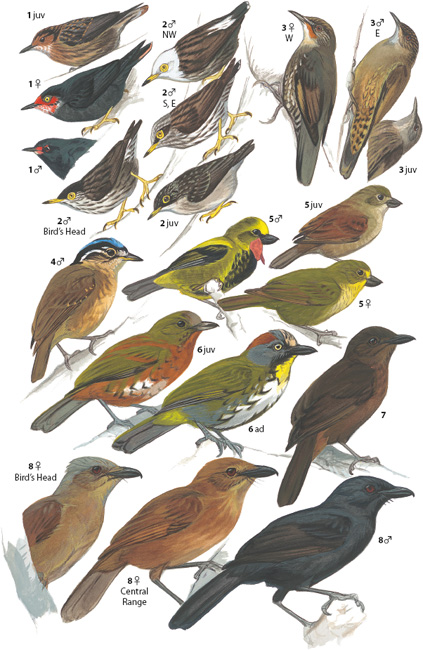
PLATE 84 PITOHUIS AND GREATER MELAMPITTA

|
1 Raja Ampat Pitohui Pitohui cerviniventris
20–21 cm. Waigeo and Batanta Is (NW Is) only. A small, insular pitohui. All plumages unique, with pale brownish-grey head and upperparts; underparts tan-brown. |
p. 457 |

|
2 Northern Variable Pitohui Pitohui kirhocephalus
20–25 cm. Lowland and hill forest, most common in edge and second growth. Adult and Juv alike. From Southern Variable P either by grey head, wings, and tail or by entirely rusty brown plumage; however, 1 subsp is black and chestnut. Eye usually dark; bill grey-brown. Subspp groups shown: kirhocephalus (Bird’s Head and Neck) grey head, wings, tail (illustrated are subspp kirhocephalus of NE Bird’s Head and decipiens of Bird’s Neck: Onin Pen); jobiensis (NW Lowlands and Yapen I) all rufous brown. Not shown are dohertyi (Bird’s Neck: Wandammen Pen) black head, wings, tail and brunneicaudus (Sepik-Ramu), like kirhocephalus but underparts paler. |
p. 456 |

|
3 Piping Bellbird Ornorectes cristatus
24–25 cm. Foothills and nearby lowlands. Locally common in forest interior where it lives on the ground and in understory. Extremely shy. Amazingly protracted, monotonous song is key to discovery. Adult is a bushy-crested, brown bird. Some have blackish face. Juv, rufous edges to wing-coverts. |
p. 449 |

|
4 Southern Variable Pitohui Pitohui uropygialis
22–25 cm. Southern counterpart of Northern Variable P. Range divided by Northern Variable at Bird’s Neck. Usually separable from that species either by black head, wings, and tail, or by these parts dusky brown, and black bill. (Black-and-chestnut race of Northern does not co-occur.) Subspp groups shown: aruensis (western S Lowlands, Aru Is) black with chestnut back, flanks, belly; brunneiceps (eastern S Lowlands) dusky brown head, wings, and tail, brown body; uropygialis (NW Is, W Bird’s Head) and meridionalis (southern SE Pen) resemble Hooded P but for black rump. |
p. 457 |

|
5 Hooded Pitohui Pitohui dichrous
22–23 cm. Common in mid-mountain forests, second growth, gardens; understory to canopy. Adult has striking pattern of orange-brown and black. Note brown uppertail-coverts, to separate from black-and-brown variable pitohuis (they have black coverts, except race dohertyi of Northern Variable). Juv, brownish edges to feathers of throat. |
p. 457 |

|
6 Greater Melampitta Megalampitta gigantea
29 cm. Associated primarily with hilly, limestone terrain and sinkholes, in which the bird shelters. Local, rare. Shy and difficult to see; best located by its loud, distinctive song. The only large, dark, terrestrial songbird. Adult is all black. Juv and Imm resemble a pitohui with black head and brown body, but note stockier shape, long legs, and shorter tail. |
p. 472 |
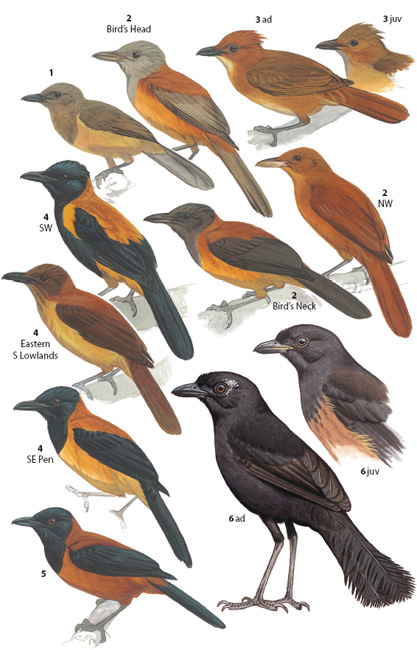
PLATE 85 SHRIKETHRUSHES, PITOHUIS, AND AUSTRAL BABBLERS

|
1 Little Shrikethrush Colluricincla megarhyncha
17–19 cm. Widespread, common in forests and scrub of all sorts, from lowlands to mid-mountains. Actually a complex of species, some identical in appearance, see text. A stocky, medium-sized songbird modestly colored in shades of brown or olive-green. Juv has rufous edges to wing-coverts and secondaries. Subspp (9 groups; 5 illustrated, for more see text): tappenbecki (Sepik-Ramu, N Huon) like despecta, grading with obscura in West; megarhyncha (Bird’s Head to S Lowlands) rufous (W), like despecta (E); despecta (SE Pen) above olive-brown, below pale rufous, throat mottled darker; obscura (NW Lowlands) above olive or brown-grey, below greyish, bill black; fortis (D’Entrecasteaux and Trobriand Is) greenish olive with grey head, breast. |
Pl. 70, p. 450 |

|
2 Grey Shrikethrush Colluricincla harmonica
23 cm. Savannahs, towns, and open lowland country, following human settlement into the highlands. Known for its powerful and musical song. Grey with white face and belly; note contrasting dark eye. Male has dark bill, immaculate underparts. Female bill greyish, underparts obscurely streaked. Juv underparts more heavily streaked, rufous wash on wings. |
p. 451 |

|
3 White-bellied Pitohui Pseudorectes incertus
22–23 cm. Riverine floodplain forest in high-rainfall lowland areas. In shy, noisy groups joined by other species. Adult is pale tan; dark beady eye prominent against the pale face. Pale bill. Juv, no information. |
p. 451 |

|
4 Rusty Pitohui Pseudorectes ferrugineus
25–28 cm. Lowland and hill forest. Common. In small groups, often with mixed-species flocks. Adult is large, rusty brown with white eye. Juv eye dark. Subspp groups shown: leucorhynchus (NW Is: Batanta, Waigeo) yellowish bill, uniform dark rusty; clarus (eastern S Lowlands, Huon, SE Pen) black bill, pale ochre breast; ferrugineus (W and N NG) black bill, plumage uniform rusty. |
p. 451 |

|
5 Grey-crowned Babbler Pomatostomus temporalis
24 cm. Locally common in Trans-Fly woodland. In noisy flocks. A dark bird with whitish head and sooty eye-stripe. Cocks black tail with white tip. Adult has pale iris. Juv has dark iris; wing-coverts edged rufous. |
p. 429 |

|
6 Papuan Babbler Garritornis isidorei
25 cm. Common in forest tangles in lowlands and hills, though may be locally absent. Always found in noisy flocks and often in mixed-species flocks. A rufous brown bird with curved, yellow-orange bill. Yellow-eyed birds are Adult. Some or all dark-eyed birds are Juv. |
p. 429 |
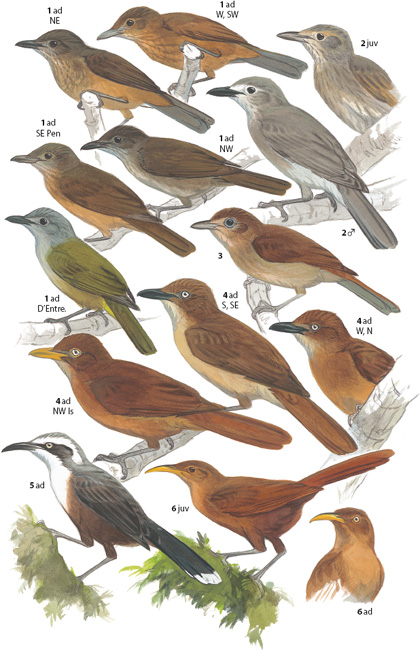
PLATE 86 GOLDEN WHISTLERS AND GOLDENFACE

|
1 Goldenface Pachycare flavogriseum
13 cm. A yellow-faced warbler with a whistler-like song. Uncommon, reclusive in the canopy of hill and lower montane forest. Female, sooty ear patch. Subspp shown: subaurantium (W, Border, and western E Ranges) orange-yellow; lecroyae (N Coastal Mts) blaze orange. Not illustrated are yellow flavogriseum (Bird’s Head and Neck) and subpallidum (eastern E Ranges, Huon, SE Pen). |
p. 422 |

|
2 Louisiade Whistler Pachycephala collaris
15–16 cm. Coastal forest on SE Is. Green-edged wing feathers and greenish tail in both sexes. |
p. 453 |

|
3 Mangrove Golden Whistler Pachycephala melanura
16–17 cm. Mangroves on mainland NG, forest on small SE Is. Wing margins silvery (not green). Male tail black (not green). Female has grey-tan breast band; tail partly black. |
p. 454 |

|
4 Baliem Whistler Pachycephala balim
15–16 cm. Montane forests of Baliem Valley. Green-edged wing. Male’s tail black, Female’s green. From co-occurring Sclater’s W by Male’s yellow collar; Female may not be separable. Juv rufous. Imm like Female, but retains brownish juv wing feathers. |
p. 453 |

|
5 Golden-backed Whistler Pachycephala aurea
15–16 cm. Second growth and tall cane grass bordering rivers and lakes in foothills and nearby lowlands. Spotty distribution. Adult has black-and-gold pattern. White throat patch obscure in some birds. Imm, olive wash. |
p. 454 |

|
6 Sclater’s Whistler Pachycephala soror
15 cm. Mid-mountain forest. Common. Male lacks yellow hind-collar. Female lacks extensive grey on the head, has broad, olive-brown breast band. Juv mostly chestnut brown. Imm similar to Female but with some juv feathering. Subsp group shown: soror (all of range except Fakfak Mts) Male head black with thick black breast band. |
p. 453 |

|
7 Regent Whistler Pachycephala schlegelii
15–16 cm. Cloud forest and subalpine shrubs. Common. Male has broad black breast band, orange-brown breast, yellow nape patch. Female head grey, chin speckled pale grey and white, grey border above olive-green breast band. Juv with much rufous brown. |
p. 452 |

|
8 Lorentz’s Whistler Pachycephala lorentzi
15–16 cm. Common in W cloud forest and subalpine scrub. Adult like female Regent W but lacks throat speckling and the olive-green breast band. Juv mostly rusty. |
p. 454 |

|
9 Vogelkop Whistler Pachycephala meyeri
14–15 cm. Bird’s Head, plus sightings in Foja Mts. Forest and thickets. Small size, small bill. Adult with pale, buff-grey ear-coverts; same color patch on sides of breast that merges with pale yellowish abdomen. Juv, no information. |
p. 454 |
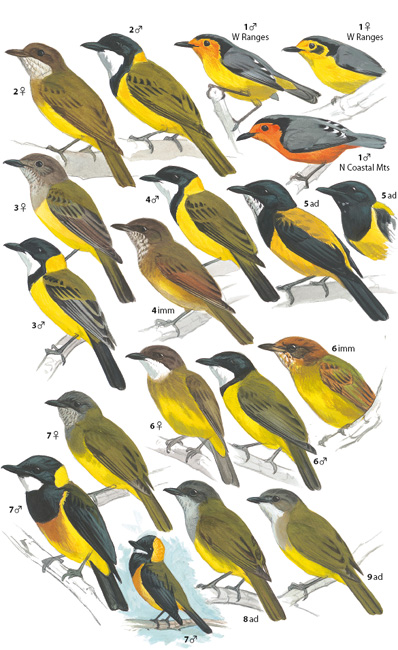
PLATE 87 PLAIN WHISTLERS

|
1 Black-headed Whistler Pachycephala monacha
15–16 cm. Widely scattered in hills and mid-mountain valleys, rarely in lowlands. Found in tall trees in open habitats. Hybridizes with White-bellied W. Male black with white lower breast and belly. Female dark grey and white. Juv rufous brown above, dingy white below. Subsp shown: lugubris (NG) upperparts sooty black. |
p. 456 |

|
2 White-bellied Whistler Pachycephala leucogastra
14–15 cm. Scarce, local in open-wooded habitats in E NG; common in forest on Rossel I (SE Is). Male black-hooded with white throat, breast. Female grey with grey breast band. Juv has streaked breast and white eye-ring, washed buff in race meeki. Imm male resembles Female but often shows indistinct dark breast band. Subspp shown: leucogastra (NG mainland) paler; Male, side of breast white; Female, whitish breast; meeki (SE Is: Rossel) darker; Male, side of breast grey; Female, breast washed buff. |
p. 456 |

|
3 Grey Whistler Pachycephala simplex
14–15 cm. The only whistler in lowland forest and regrowth, where common. Extends up into lower mountains. Small, dainty. Adult plain; diagnostic pale eyebrow and pale throat. Juv largely rufous. Subspp groups shown: simplex (SE Pen and D’Entrecasteaux Is) brown with pale brownish breast; griseiceps (rest of NG range) olive with pale yellowish belly and flanks, greyish cap. |
p. 455 |

|
4 Brown-backed Whistler Pachycephala modesta
14 cm. Eastern cloud forest and subalpine scrub. Common. Small size. Adult has grey crown, white throat. Breast off-white (East) to pale grey (West). Juv rufous brown. |
p. 455 |

|
5 Rusty Whistler Pachycephala hyperythra
15 cm. Hill forest midstory. Locally common. Adult brown with tan or orange-tan underparts. Grey cap; white or pale grey throat. Juv rufous. Subspp groups shown: hyperythra (Bird’s Head to western S Lowlands) rufous brown above, indistinct throat; sepikiana (NW Lowlands to Sepik-Ramu) olive brown above, orange-tan below; salvadorii (eastern S Lowlands, Huon, SE Pen) grey-brown above, tan below. |
p. 455 |

|
6 Island Whistler Pachycephala phaionota
16–17 cm. On tiny islets in Indonesia, in all wooded habitats. Adult brown with greyish head, white throat, and dull white underparts. Juv, top and sides of head olive brown. |
p. 455 |

|
7 Mottled Berryhunter Rhagologus leucostigma
15–16 cm. Montane forest interior. Elusive, but locally common. Locate by loud, slow-paced, whistled song. Female and Juv more ornate: dark olive with rusty face; streaked and spotted; Juv iris dark. Male drab; differs by subspecies. Subspp shown: obscurus (Border Ranges to SE Pen) Male greyish olive with faint white throat spotting; leucostigma (Bird’s Head to W Ranges) sexes alike but Male duller. |
p. 448 |
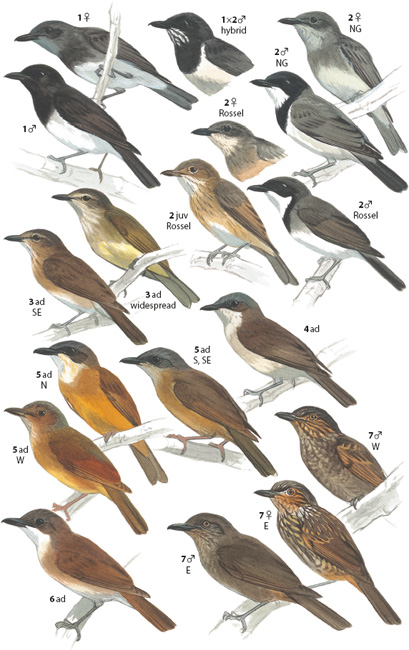
PLATE 88 MYIAGRA FLYCATCHERS

|
1 Shining Flycatcher Myiagra alecto
16–18 cm. Lowland thickets near water in swamp forest, mangroves, second growth. Common. Forages near the ground. Male shiny blue-black; note angular head. Female bright orange-rufous with black cap and white underparts (may be tinged buff). Juv, dull black cap. Imm male similar to Female but often with black sides of neck. |
p. 461 |

|
2 Biak Black Flycatcher Myiagra atra
13–14 cm. Biak and Numfor only. In all types of forest, though most common in hilly country. Small. Male entirely blue-black. Female and Juv slate grey above, paler below. |
p. 460 |

|
3 Restless Flycatcher Myiagra inquieta
16–18 cm. Savannah, edge of gallery forest, and scrub bordering rivers, entering sedge beds at riverside. Common. Hovers near ground while hunting, uttering distinctive call. Adult glossy blue-black above, white below, including throat. Juv duller and shows white wing bars and streak across scapulars. |
p. 461 |

|
4 Satin Flycatcher Myiagra cyanoleuca
15 cm. Rare overwintering AU migrant to open country and forest edge, from lowlands to mid-mountain valleys. Male’s black-white division on breast is concave, running under the wing at a sharp angle. Female from Leaden F female by darker upperparts with solidly dark wings and grey-brown undertail (not grey). Imm Male resembles Female but often with dark smudging. |
p. 461 |

|
5 Broad-billed Flycatcher Myiagra ruficollis
15–16 cm. Rare mangrove specialist; also locally in thickets along river oxbows; usually under cover and only a few meters above the ground or water. Adult resembles female Leaden F; distinguished by broad bill, tips of tail feathers not overlapping completely, and glossy crown. Female differs from male Broad-billed or female Leaden by paler throat and lores. Juv from juv Leaden by wide bill, graduated tail, and association with parents. |
p. 460 |

|
6 Leaden Flycatcher Myiagra rubecula
13–16 cm. Locally common in open lowland habitats—savannah, mangroves, forest edge, settlements. Year-round resident; also an AU migrant during austral winter. Male from male Satin F by dull, slaty blue-grey upperparts; grey-white division cuts across breast in a bulging line and meets the wing at a right angle. Female and Imm, from female Satin F by paler upperparts and pale margins to the secondaries; from Broad-billed F by the narrower bill and tail feathers of even length. Juv grey-brown above with pale eyebrow, white streak across the scapulars; whitish below. NG and AU races indistinguishable in the field. |
p. 460 |
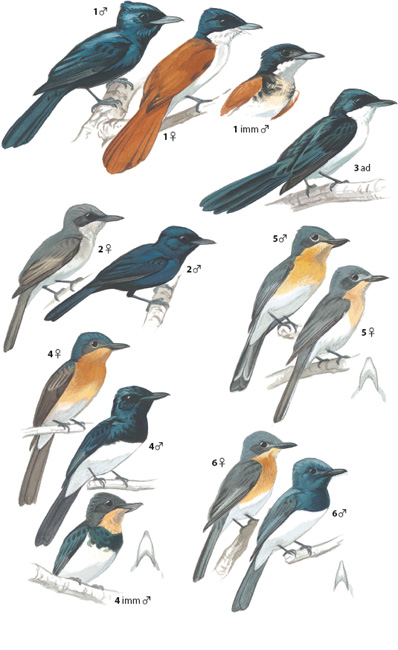
PLATE 89 MONARCHS OF THE FOREST INTERIOR

|
1 Spot-winged Monarch Symposiarchus guttula
14–15 cm. Lowland and hill forest interior. Common. Small. Flashy white tail spots. Adult grey and white with black face; white wing spots. Juv/Imm as shown. |
p. 464 |

|
2 Kofiau Monarch Symposiachrus julianae
15 cm. Kofiau I (NW Is) only, where Spot-winged M is absent. Common in forest. Adult, blackish upperparts, no wing spots (or obscure). |
p. 464 |
|
3 Biak Monarch Symposiachrus brehmii
15–16 cm. Biak (Bay Is) only. Rare in lowland forest. Adult has unique bold pattern of pale yellow and black; note distinctive, pale, tear-shaped patch on the ear-coverts. Juv resembles juv Spectacled M but with mostly whitish outer tail feathers. |
p. 464 |

|
4 Hooded Monarch Symposiachrus manadensis
15–16 cm. Forest of foothills and adjacent lowlands. Uncommon and local. Adult’s black breast-bib framed by white sides. Juv and Imm as shown. |
p. 463 |

|
5 Spectacled Monarch Symposiachrus trivirgatus
15 cm. Resident on SE islands in lowland and hill forest. Also rare AU migrant to Trans-Fly monsoon forest. Adult from Spot-winged M by cinnamon breast, spotless wing, and shape of face mask. Note white in tail. Juv and Imm from juv Spot-winged by grey chin instead of throat. Subspp shown: melanopterus (resident SE Is) shoulders black, breast pale rufous; gouldii (AU migrant to Trans-Fly) shoulders grey (same as back), breast rich rufous. |
p. 464 |

|
6 Fantailed Monarch Symposiachrus axillaris
15–16 cm. Mid-mountain forest. Uncommon. Fantail-like. Small white tuft at the bend of wing. Male satiny black. Female duller. Juv has browner flight-feathers; lacks white tufts. |
Pl. 92, p. 463 |

|
7 Rufous Monarch Symposiachrus rubiensis
18 cm. Lowland and foothill forest interior. Uncommon and patchily distributed. A large monarch, entirely rich rufous brown. Face black in Male, rufous in Female and Juv. |
p. 463 |

|
8 Frilled Monarch Arses telescopthalmus
15–16 cm. Lowland and hill forest interior. Blue, fleshy eye-skin. Male with snowy white ruff and white patch on back. Female and Juv from Ochre-collared by rufous collar same color as back and wing. Subspp groups shown: telescopthalmus (excluding range of next subsp) Female belly white; henkei (SE Pen) Female belly buff in the North, white or buff in South. |
p. 462 |

|
9 Ochre-collared Monarch Arses insularis
15–16 cm. Northern counterpart of Frilled M. Male has ochre throat and ruff. Female and Juv have rufous collar contrasting with grey-brown saddle and white belly. |
p. 462 |
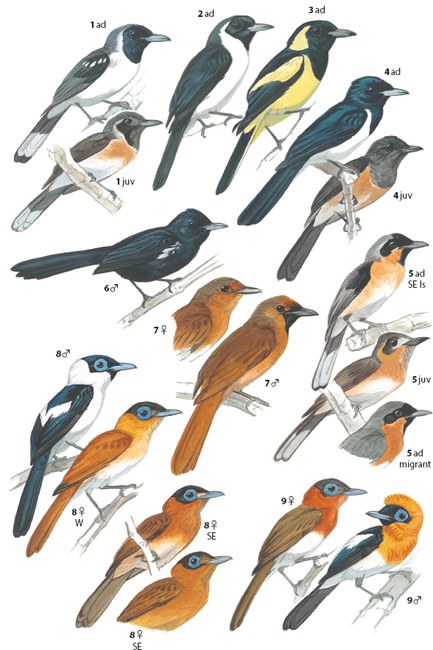
PLATE 90 MONARCHS OF THE FOREST CANOPY

|
1 Golden Monarch Carterornis chrysomela
13–14 cm. The common treetop monarch in lowland and hill forest. Sexes differ, but both show the unique, white tear-spot below eye. Male shows striking black-and-yellow pattern; note yellow wing patch. Female yellowish olive, look for white tear-spot. Juv similar to Female, but bill black with yellowish base. Subspp groups shown: chrysomela (all of range except for Biak) Female mostly all green; kordensis (Biak I) Female resembles Male, but lacks black face, Male deep orange. |
p. 465 |

|
2 Black-breasted Boatbill Machaerirhynchus nigripectus
13–14 cm. The highland boatbill; common in forest and edge. Black patch in the middle of the breast and yellow (not white) throat. Female duller black, medium yellow below, breast patch smaller and more ragged, black eye-stripe extends behind eye. Juv female duller and may have scalloped breast. |
p. 438 |

|
3 Yellow-breasted Boatbill Machaerirhynchus flaviventer
11–13 cm. The boatbill of lowland and hill forest. Uncommon and inconspicuous. Small, yellow-breasted bird with white throat. Female dusky olive above, paler yellow below, with faint dusky markings on throat and flank; black eye-stripe passes through eye. Juv resembles the Adult of its sex but shows reduced wing bars; Male’s underparts with faint dusky markings, Female’s often heavily dark-scalloped. Subspp groups shown: albifrons (NW Is, Bird’s Head to Sepik-Ramu) forehead and eyebrow white; xanthogenys (S Lowlands, Huon, SE Pen) these parts yellow. |
p. 438 |

|
4 Black-winged Monarch Monarcha frater
18 cm. The common monarch of treetops and edge of hill and mid-mountain forests. A resident species, though AU race overwinters in NG somewhere. From Black-faced M by striking contrast between pale grey body and black wings, tail, and face. Adult has well-defined black mask; blue bill. Imm, black mask small and poorly defined, wings brownish grey (not black), bill dark. Subspp groups: frater (Bird’s Head, northern W Ranges) and canescens (AU) eye and mask separate; kunupi (Weyland Mts) and periophthalmicus (remainder of NG) mask joins with eye. |
p. 466 |

|
5 Islet Monarch Monarcha cinerascens
17–19 cm. Small-island specialist. Forest and edge, coastal strand. Common. A large, sluggish monarch. Adult dull grey with cinnamon breast; note beady eye. Juv has buffy wash from throat to breast, brownish edges to wings and dark bill. |
p. 465 |

|
6 Black-faced Monarch Monarcha melanopsis
17–19 cm. Breeds AU, migrates to eastern NG and SE Is during austral winter; some imm birds remain over summer. Common in all forest types and edge, mainly in lowlands. Diagnostic pale grey eye-patch in all plumages. Adult has black forehead and throat. Imm lacks black mask, is blue-grey like Adult, but retains brown-grey juv wings; note pale loral spot; some may be inseparable from same-age Island M. |
p. 465 |
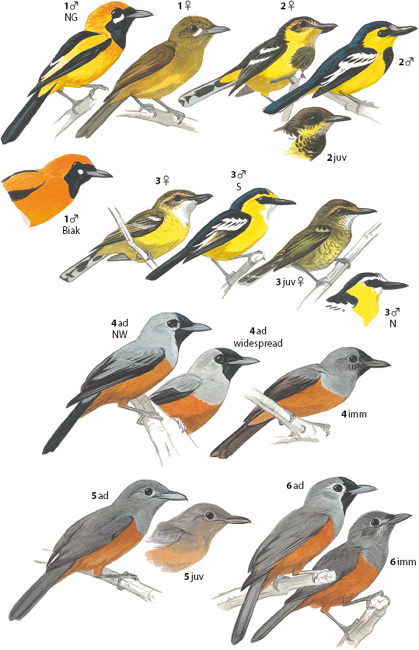
PLATE 91 GREY FANTAILS

|
1 Northern Fantail Rhipidura rufiventris
17–18 cm. The common fantail of forest and edge of lowlands, hills, and mid-mountains. Adult grey or black, lacks white wing markings. Juv duller, wing-coverts tipped buff. Subspp shown: kordensis (Biak) black with white belly and strong white eyebrow; gularis (widespread NG form) grey with buffy belly; nigromentalis (SE Is: Misima, Tagula) black chin, white tail tips larger. Not shown is vidua (NW Is: Gag, Gebe, Kofiau) breast band pale-spotted, belly white. |
p. 471 |

|
2 Mangrove Fantail Rhipidura phasiana
13–14 cm. In mangroves only; locally common. Adult is a small, pale grey fantail with white eyebrow and white wing bars. Juv is paler, with upperparts suffused with buff. |
p. 471 |

|
3 Chestnut-bellied Fantail Rhipidura hyperythra
14–15 cm. Hilly lowlands to mid-mountain forest. Common. Adult slaty grey above, rich rufous below. Juv paler, duller below; wing-covert spots rufous. |
p. 470 |

|
4 Friendly Fantail Rhipidura albolimbata
14–15 cm. Cloud forest interior, edge, and openings. Common. Adult sooty-colored with white facial markings, wing bars. Juv wing bars and underparts buffy. |
p. 470 |

|
5 Willie Wagtail Rhipidura leucophrys
17–20 cm. Towns and gardens; originally savannah, beaches, lagoons, and riverside clearings. Wags entire body, calling persistently. Adult black except for white belly and eyebrow. Juv duller; bigger white eyebrow; buff tips to wing-coverts. |
p. 468 |

|
6 Black Thicket-Fantail Rhipidura maculipectus
18–19 cm. Lowland forest edge, swamp forest, mangroves, and second growth. Local and uncommon, secretive. Closely resembles White-bellied TF, except overall more blackish, and the belly is black; also, the central tail feathers lack white tips. Female duller, with reduced wing-spotting. Juv sooty black with much reduced white markings; tail pattern same. |
p. 468 |

|
7 White-bellied Thicket-Fantail Rhipidura leucothorax
18 cm. Forages near the ground in thickets in gardens, forest edge, and disturbed forest in lowlands and hills. Locally common and often heard, but keeps to cover. Adult’s black face marked with a prominent white eyebrow and white submoustachial patch; belly white; all tail feathers white-tipped. Juv greyer; all-dark bill; black breast band spotted white. |
p. 468 |

|
8 Sooty Thicket-Fantail Rhipidura threnothorax
17–18 cm. Thickets within forest interior in the lowlands. Common and vocal, but secretive. Tail all black, lacking white tips. All-white throat. Male darker; Female browner. Juv paler, with breast and belly grey marked by pale shaft streaks. |
p. 469 |
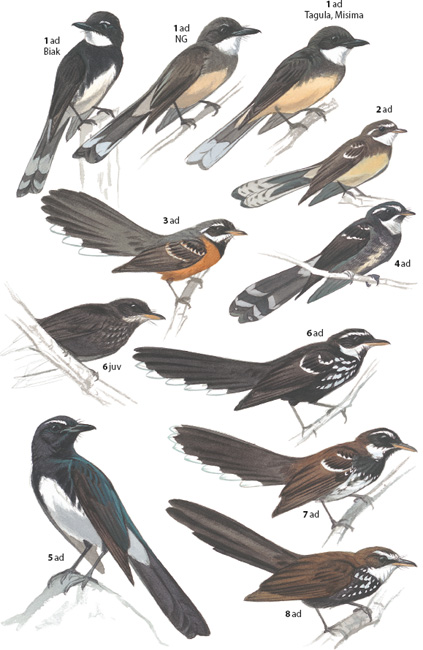
PLATE 92 BROWN FANTAILS

|
1 Rufous-backed Fantail Rhipidura rufidorsa
13–14 cm. Lowland and hill forest interior. Common. The plainest and smallest lowland fantail. Adult, grey head and dingy white underparts. Juv similar, tail shorter. |
p. 469 |

|
2 Arafura Fantail Rhipidura dryas
14–15 cm. This species and Rufous F are very similar but have different ranges. They share a rufous patch at the base of the tail and a black throat “necklace.” Arafura F differs in the small rufous patch at base of tail and the tail tip is always white. Subspp shown: squamata (forests of NW Is, Aru Is; also Banda Is) black forehead, white eyebrow; streptophora (mangroves S Lowlands and possibly Gulf of Papua) extensive rufous forehead, difficult to separate from Rufous F. |
p. 470 |

|
3 Rufous Fantail Rhipidura rufifrons
14–15 cm. Common resident on small SE Is; uncommon AU migrant to Trans-Fly; both inhabit forest. Adult, broad rufous tail patch; narrow pale tail tip. Juv duller, browner, with rufous tips to wing-coverts, necklace reduced. Subspp groups shown: louisiadensis (SE Is, endemic) white tail tip; rufifrons (migrates to Trans-Fly from AU) grey tail tip. |
p. 469, 470 |

|
4 Dimorphic Fantail Rhipidura brachyrhyncha
15–16 cm. Cloud forest and subalpine shrubland. Common. Small, pale brown fantail. Rufous rump and lower back. DARK MORPH: Blackish tail with broad rufous tip and dull ochraceous underparts; PALE MORPH: All ashy-grey tail and pale grey-brown underparts. |
p. 469 |

|
5 Black Fantail Rhipidura atra
16–17 cm. Montane forest. Common in undergrowth. Male velvety black with small white eyebrow. Female and Juv rufous with black central tail feathers. |
p. 470 |
|
6 Fantailed Monarch Symposiachrus axillaris
15–16 cm. For comparison with co-occurring Black F. Note bluish bill and white flank patch. |
Pl. 89, p. 463 |
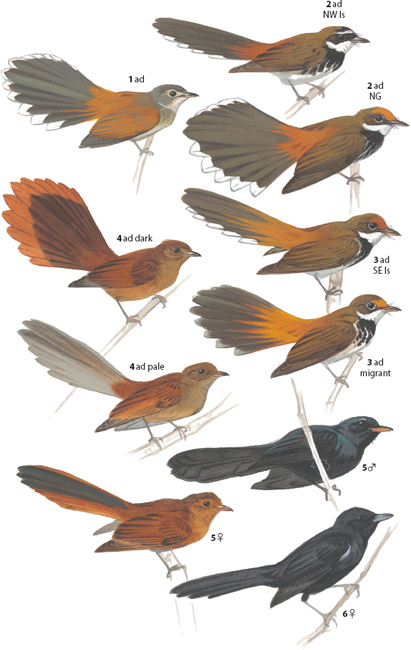
PLATE 93 MANUCODES AND CROWS
Manucodes are birds of paradise in which the males and females look the same. They live in the lowlands and lower mountains and feed mainly on fruit, especially figs. Their exaggeratedly floppy and undulating flight is diagnostic.

|
1 Trumpet Manucode Phonygammus keraudrenii
28–33 cm. Lower montane forest and S Lowlands. Smaller than other manucodes. Adult with diagnostic shaggy nape crest; iris red. Male larger. Juv and Imm dull blackish with short hackles; iris grey-brown. Subspp shown: jamesii (S NG: S Lowlands to SE Pen, Aru Is) lowlands, greenish blue, ooo-uh call; purpureoviolaceus (E Ranges and SE Pen) montane, large, purplish, deep voice; hunsteini (SE Is: D’Entrecasteaux) very large, less glossy, with slightly twisted tail. |
p. 474 |

|
2 Curl-crested Manucode Manucodia comrii
43 cm. Common, crow-sized frugivore found in all wooded habitats within its restricted island range. Adult distinctive; iris red-brown. Male larger. Juv and Imm blacker, duller, lack curling feathers; iris brown. Shares habitat with smaller Trumpet M. |
p. 474 |

|
3 Jobi Manucode Manucodia jobiensis
30–36 cm. Lowlands. Nearly identical to Crinkle-collared M but lacks “bump” above eye and has slightly smaller bill, shorter tail, and subtle color differences (see account). |
p. 475 |

|
4 Crinkle-collared Manucode Manucodia chalybatus
33–37 cm. Hill and lower montane forest; also scrub in highland valleys. Common but shy. Adult has a diagnostic “bump” above each eye; crinkled feathers of breast and mantle show as alternating bands of black and iridescence; iris red. Male larger. Juv and Imm blacker, duller, with feather-crinkling absent; iris brown. |
p. 475 |

|
5 Glossy Manucode Manucodia ater
Male 38–42 cm, Female 33–37 cm. Lowland forest edge and open woods. Largest mainland manucode, with longest tail. Sleek, thin-necked. Breast, mantle glossy, lacking crinkled feathers. Subspp shown: ater (widespread) green, blue, or purple gloss; song a whistled tone, eeeEEEEee; alter (SE Is: Tagula) larger with more massive bill, purple gloss, and deep song mmm. |
p. 476 |

|
6 Torresian Crow Corvus orru
46 cm. The common black crow of coasts, settlements, and open lowland country. Adult shiny black. Juv, Imm duller, iris matures from grey, to brown, to hazel, to white. |
p. 472 |

|
7 Brown-headed Crow Corvus fuscicapillus
46 cm. Uncommon and very patchy in lowland forests of the West. Robust, with large, high-arched bill and short, square tail. Brownish. Juv plumage paler; bill all yellow. |
p. 471 |

|
8 Grey Crow Corvus tristis
51–56 cm. Lowland and hill forest. Common, in noisy family groups. A lanky, long-tailed crow with bare, pink face. Adult sooty-brown; bill slaty grey. Juv paler greyish; bill pink. |
p. 472 |
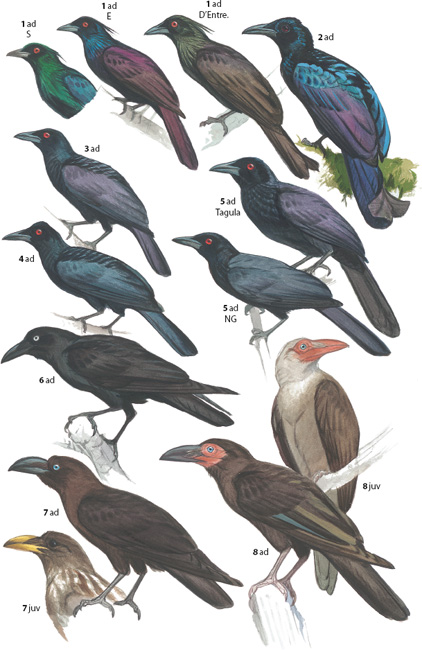
PLATE 94 BIRDS OF PARADISE—PAROTIAS
Parotias are moderately large birds of paradise that dwell in mid-mountain forest, where they are locally common. The 6 flagged, wiry plumes projecting from behind the eyes gave rise to the name “six-wired birds of paradise.” Both males and females are best recognized by their chunky shape and yellow or blue-and-yellow eyes. Parotias feed mainly on fruit but also forage by hopping along branches and picking invertebrates from the bark and epiphytes. The male displays at a “court” on the ground that he has cleared of leaves. The court is situated in a tree-fall gap. Male calls of Carola’s and Bronze Ps are higher pitched and ringing; calls of the other species are explosive, harsh, cockatoo-like screams.

|
1 Western Parotia Parotia sefilata
30–33 cm. Bird’s Head and Neck. Male from other parotias by the combination of medium-length tail and white forehead. Female, Juv, or Imm distinguished by the paler underparts and darker upperparts that show less contrast with the black head. Compare with Superb BoP female race superba, plate 97. |
p. 476 |

|
2 Lawes’s Parotia Parotia lawesii
25–27 cm. E Ranges and SE Pen. Common. Male has a long, gleaming white patch above bill and very short tail. Female, Juv, and Imm are black-headed, blue-eyed, and deep brown on the body. Compare with Eastern P and female Superb BoP races latipennis and minor, plate 97. |
p. 477 |

|
3 Eastern Parotia Parotia helenae
25–27 cm. Northern SE Pen. Both sexes nearly identical to Lawes’s P but differ in forehead profile, which is steep and more concave in Eastern vs sloped and more tapered in Lawes’s. Eastern thus has a rounder head-shape. Male has small, bronze-colored patch over the bill. Female, Juv, and Imm have reduced feathering over the bill, leaving half or more of bill tip exposed (less exposed in Lawes’s), culmen (dorsal ridge of the bill) sharply keeled (angular or slightly rounded in Lawes’s). |
p. 477 |

|
4 Wahnes’s Parotia Parotia wahnesi
Male 43 cm, Female 36 cm. Huon Pen (locally common) and Adelbert Mts (nearly extinct). Tail longest of all parotias. Male with golden frontal crest. Female, Juv, and Imm are russet dorsally in contrast to the black head; note pale eye-stripe and moustachial streak. |
p. 477 |

|
5 Bronze Parotia Parotia berlepschi
Male 26 cm. Foja Mts sister-species of Carola’s P. Differs by the pale grey-blue iris of both sexes and the Male’s blackish face and throat and overall bronzed cast. |
p. 478 |

|
6 Carola’s Parotia Parotia carolae
25–26 cm. Note yellow eye. Male shows diagnostic white flank plumes and buffy face and throat. Female, Juv, and Imm recognized by their cream-colored iris and the pale stripes above and below eye. Compare with female Superb BoP race feminina, plate 97. |
p. 478 |
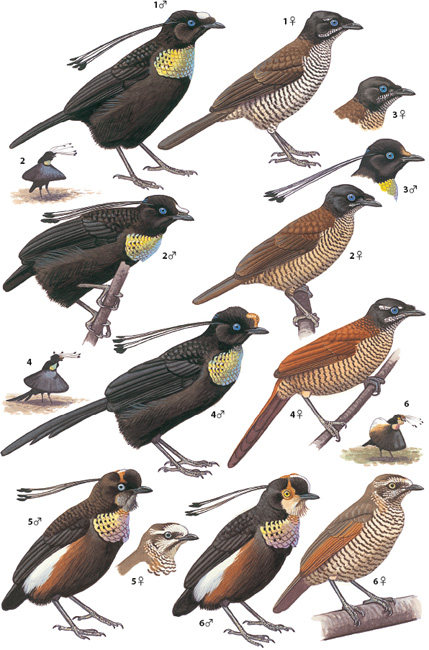
PLATE 95 BIRDS OF PARADISE—ASTRAPIAS
Astrapias are long-tailed birds of paradise with short bills. The 5 species replace each other regonally across the high mountains of New Guinea, with overlap only between Ribbon-tailed and Stephanie’s. They feed on fruit (especially Schefflera) and methodically forage on branches for insects and other small animal life. Males’ wings hiss loudly in flight—a good means of detection because otherwise the birds are mostly silent. As far as is known, all species display in treetops on ridges and at edges of clearings. Males display while hanging beneath a branch or in flight.
Astrapias form 1 of 2 genera of long-tailed birds of paradise, the other being the montane sicklebills. Female-plumaged astrapias and sicklebills are quite similar and often feed together. Sicklebills have long, curved bills and more pointed tails, and the females show a brown cap.

|
1 Arfak Astrapia Astrapia nigra
Male 76 cm, Female 50 cm. Arfak mts. Uncommon. Male blackish with green breast and extremely long, broad, round-tipped tail. Unique paired nape crest and bronze neck-stripe. Female, Juv, and Imm with the least amount of pale barring below of any astrapia. |
p. 482 |

|
2 Huon Astrapia Astrapia rothschildi
Male 69 cm, Female 47 cm. Huon mts. Common. Similar to Arfak A, but Male lacks bronze neck-stripe and has a purplish nape shield. Female, Juv, and Imm show more pronounced narrow whitish bars on breast and belly. See Spangled Honeyeater (plate 73). |
p. 482 |

|
3 Ribbon-tailed Astrapia Astrapia mayeri
Male 125 cm, Female 53 cm. Western sector of the E Ranges. Common. Male has a pompom atop bill, and a stupendous pair of narrow, white, ribbonlike central tail feathers. Female, Juv, and Imm show a distinctive greenish sheen on head with a small tuft over the base of the bill, and the central tail feathers are pointed and much longer than the rest. These feathers may show some white on the shaft and as blotches near the base, rarely being extensive like the Male’s. Range overlaps that of Stephanie’s A, with which Ribbon-tailed hybridizes. Ribbon-tailed above ~2700 m, Stephanie’s below. |
p. 482 |

|
4 Stephanie’s Astrapia Astrapia stephaniae
Male 84 cm, Female 53 cm. Eastern cordillera, overlapping in the West with Ribbon-tailed. Common. Male is black with iridescent green head, bronze breast band, and spectacular, long, all-black, central tail feathers. Female, Juv, and Imm have a black head and buff-brown underparts with fine blackish barring. Compared with female Ribbon-tailed A, head lacks obvious green sheen and tuft over base of bill, and the tail is evenly graduated with blunt feather tips and does not show any white. |
p. 483 |

|
5 Splendid Astrapia Astrapia splendidissima
Male 39 cm, Female 37 cm. Western cordillera. Common. Male predominantly greenish and highly iridescent with unique paddle-shaped, black-and-white tail. Female, Juv, and Imm much duller but also show white in the base of the tail, which is evenly graduated (central feathers much longer in Ribbon-tailed A). |
p. 482 |
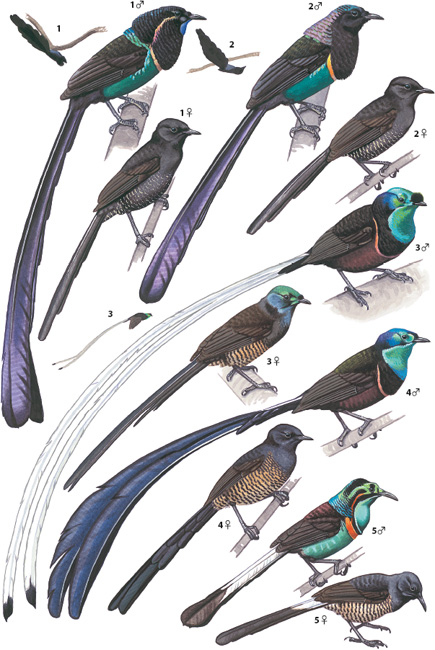
PLATE 96 BIRDS OF PARADISE—SICKLEBILLS
The Black and Brown Sicklebills are large birds of paradise with a long, downcurved bill and a very long, pointed tail. They live in the high mountains, where the males maintain large territories. The males are black with flank-plumes and iridescent highlights. They display on a snag or branch, stretching themselves horizontally. Sicklebills often associate with astrapias, which are superficially similar but have a short, straight bill and blunt-tipped tail, and the male’s wings hiss in flight.
The Black-billed and Pale-billed Sicklebills live at lower elevations, and males are also territorial. These sicklebills have a medium-length tail and are similar in size and shape to other co-occurring birds of paradise, from which they can be distinguished by the distinctive sickle-shaped bill and rounded, pale buff or cinnamon tail.

|
1 Black Sicklebill Epimachus fastosus
Male 110 cm, Female 55 cm. Inhabits the transition from mid-mountain to cloud forest. Rare and local. Seen foraging on trunks and branches in the canopy or midstory or at fruit trees. Male Black S differs from Brown S in darker breast and red (not pale blue) iris. His song is best means of discovery: a far-carrying KWINK! KWINK! Sings in early morning from a prominent branch. Female, Juv, Imm separated from Brown S by rusty wing edges contrasting with the rest of the upperparts and the dark brown iris. Subsp shown: atratus (Bird’s Neck and Central Ranges). |
p. 481 |

|
2 Brown Sicklebill Epimachus meyeri
Male 96 cm, Female 52 cm. Mossy cloud forest, above the elevations of other sicklebills. Common. Male differs from Black S by the brown underparts, pale blue iris, and jackhammer song in 2 bursts: TAT-AT-AT TAT-AT-AT. Female, Juv, Imm from Black S by the olive-brown wing edge (same as rest of wing) and pale blue iris. |
p. 480 |

|
3 Pale-billed Sicklebill Drepanornis bruijnii
34–35 cm. Lowland forest. Easily located by song, but difficult to observe in the canopy. Joins mixed flocks. Long, curved, ivory-colored bill; large, bare eye-patch; and “Mohawk haircut.” Chestnut tail. Male is dusky-bodied. See account for unique song of varied hollow whistles. Female, Juv, Imm barred below. Slightly larger, darker, and more compact than Black-billed S of the mountains. |
p. 480 |

|
4 Black-billed Sicklebill Drepanornis albertisi
33–35 cm. Mid-mountain forests. Patchily distributed. Uncommon and easily overlooked. In flight, diagnostic buff tail. Black bill distinguishes it from lowland-dwelling Pale-billed S. Male has a diagnostic pattern from below: smooth grey breast contrasts with white belly and vent. Song is a series of loud, piping notes. Female, Juv, Imm have abundant fine barring below. |
p. 480 |
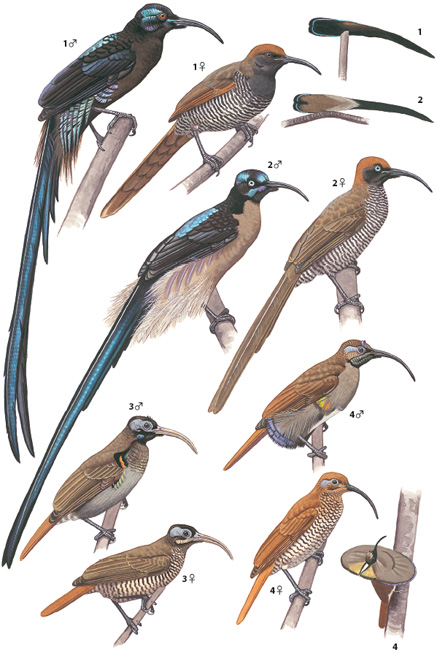
PLATE 97 BIRDS OF PARADISE—MISCELLANEOUS HIGHLAND SPECIES
Other highland birds of paradise include the parotias, astrapias, and sicklebills.

|
1 King of Saxony Bird of Paradise Pteridophora alberti
20–22 cm. A small, uncommon canopy dweller of the interior of cloud forest. Male black with a pale ochre breast and belly, and two remarkable, stiff head-plumes that can be moved around like the antennae of a long-horned beetle. Broad, orange-buff wing band in flight. The territorial Male sings in early morning and late afternoon from a high, open perch, usually a dead branch, but displays to Female on a vine in understory. Female, Juv, Imm are obscure-looking—the small bill, grey plumage, and fine, scalloped barring below suggest something other than a bird of paradise, perhaps a whistler or bowerbird. |
p. 476 |

|
2 Long-tailed Paradigalla Paradigalla carunculata
35–37 cm. The paradigalla on the Bird’s Head. From Short-tailed P by the longer, graduated tail and blue-and-red gape wattles. Male with iridescent crown; Female duller. Juv unknown, but believed to be similar to that of Short-tailed P. |
p. 481 |

|
3 Short-tailed Paradigalla Paradigalla brevicauda
22–23 cm. Middle and upper stories of mossy cloud forest. Distinctive compact shape with narrow bill and short tail. Yellow forehead wattles; blue gape wattles. Male crown exhibits greenish, scaly iridescence. Female duller, longer-tailed, and smaller. Juv very dull, lacking iridescence. Polygynous, but display unknown. Songs/calls include a melodious hoo-ee? or rising zheee. Also a high-pitched, mournful, 4-note whistling. |
p. 481 |

|
4 Superb Bird of Paradise Lophorina superba
25–26 cm. Mid-mountain forest, disturbed areas, and even casuarina and oak copses in highland valleys. Common. Small size. Male unique for blue-green breast shield that is shaped like a pair of wings and the long, thick, black nape-plume (actually a folded cape). Sings from the canopy—a harsh series of 5–8 shree notes—but displays on a log on or near the ground. Female, Juv, Imm regionally variable, and color pattern resembles the parotia species in their area. Subspp groups shown: superba (Bird’s Head and Neck) Male lacks the black spots on breast shield and song differs, Female has very dark head and upperparts; feminina (W and Border Ranges) Female’s crown wreathed and speckled; latipennis (E Ranges to Wau and Herzog Mts) Female variable and intermediate; Not shown is minor (SE Pen) Female has black head, brown back, and usually lacks an eyebrow. |
p. 479 |
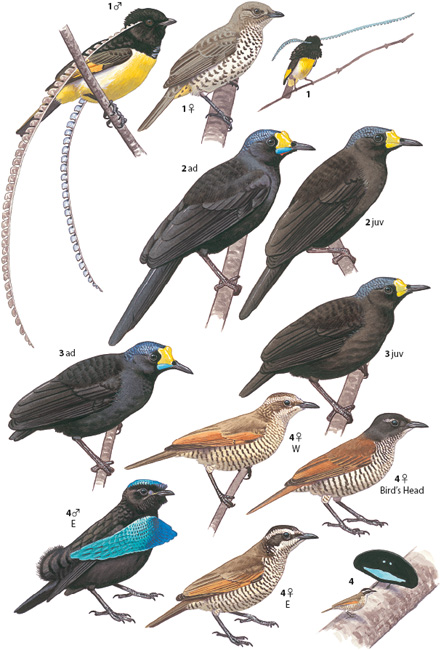
PLATE 98 BIRDS OF PARADISE—MISCELLANEOUS LOWLAND AND HILL SPECIES
Other lowland and hill BoP include the manucodes, Pale-billed Sicklebill, and paradisaeas.

|
1 Magnificent Riflebird Ptiloris magnificus
Male 34 cm, Female 28 cm. The 2 riflebird species are nearly identical and are separated mainly by range and voice. Both are vocal inhabitants of the interior of lowland and hill forest. Males are terribly shy. The female-plumaged riflebirds are often seen in mixed flocks of other rufous species. Both sexes recognized by distinctive shape: robust with longish neck, tapered head, and long bill. Males’ wings rustle in flight. He displays on a branch or thick horizontal vine. Female, Juv, Imm: note whitish eyebrow and moustachial stripe and dark legs. Male Magnificent’s song is 2–3 colossal, upsweeping, musical whistles. |
p. 479 |

|
2 Growling Riflebird Ptiloris intercedens
Male 34 cm, Female 28 cm. Song is a 2-noted growl. This species’ feathered culmen and Male’s shorter flank plumes are difficult to discern in the field—see species account. |
p. 479 |

|
3 Twelve-wired Bird of Paradise Seleucidis melanoleucus
33–35 cm. Swampy lowland forest and regrowth. Best seen along rivers. The wary Male may be tracked down by his powerful song and hissing wings, or in early morning at his display site atop a dead spire. Song similar to paradisaeas, short series of harnh, haw, or koi notes. The more approachable Female is often seen in mixed flocks. Female, Juv, Imm diagnostic with reddish-brown back and tail, black cap, and finely barred underparts. Unique red iris and pink legs. Long chisel-bill is prominent. |
p. 478 |

|
4 Magnificent Bird of Paradise Diphyllodes magnificus
19 cm. Hill and lower mid-mountain forest. Common but seldom seen except at fruiting trees or display court—a cleared space on the ground around a thin sapling. Song a series of ~8 loud, downslurred chur notes rapidly delivered. The only small mainland bird of paradise with bright blue-grey bill and legs. Male colors muted in the forest gloom; look for tail wires and contrasting dark ventral and light dorsal pattern. Female, Juv, Imm identified by the blue-grey eye-stripe, bill, and legs. |
p. 484 |

|
5 Wilson’s Bird of Paradise Diphyllodes respublica
16 cm. Hill forest on Waigeo and Batanta Is. Unique bald, cobalt-blue crown with black lines. Male’s red back easy to spot. Habits and voice similar to Magnificent BoP. |
p. 484 |

|
6 King Bird of Paradise Cicinnurus regius
Male 16 cm, Female 19 cm. Lowland and foothill forest, edge, and second growth. Common but difficult to observe. The smallest mainland BoP. Male unique. He sings and displays from a subcanopy tangle of shaded vines in the forest interior. Song is a slow, swelling series of nasal, paradisaea-like notes: rahn rahn rahn rahn … or a rapid ki kyer kyer kyer kyer kyer …. Female, Juv, Imm lack facial markings but have a diagnostic head shape with long, tapered profile, and pale yellow bill. |
p. 483 |
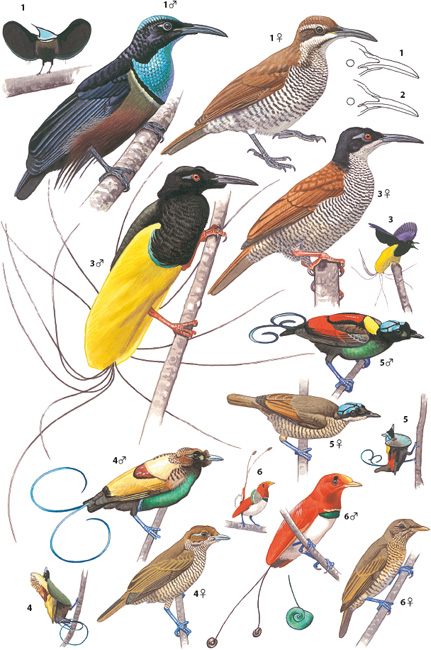
PLATE 99 BIRDS OF PARADISE—PARADISAEAS WITH SMALL RANGES
The “plumed birds of paradise” are the common and characteristic birds of paradise in lowland and hill forest, edge, and regrowth, including near human settlement. Their songs are heard persistently through the forest: a loud WAU WAU WAU … and similar notes. The plumed birds can be divided into 2 groups: the 4 species with small ranges (this page) and the 3 “typical” plumed birds (next page). Males of all but the Blue BoP display in communal leks high in the treetops; the male Blue BoP displays alone in the midstory.

|
1 Goldie’s Bird of Paradise Paradisaea decora
Male 33 cm, Female 29 cm. Hill forests of Fergusson and Normanby Is, locally in the lowlands. Male has reddish flank plumes, yellow crown and back, and unique grey breast. Female, Juv, Imm show a dull yellow crown, chocolate throat, and finely barred breast, unusual for a Paradisaea. |
p. 485 |

|
2 Red Bird of Paradise Paradisaea rubra
Male 33 cm, Female 30 cm. Waigeo, Batanta, and some nearby islands. Male has curved red flank plumes and a pair of prominent, long, curling, black tail-streamers. Female, Juv, Imm are chocolate-faced and with broad breast band of dull yellow that connects to yellow nape. |
p. 485 |

|
3 Emperor Bird of Paradise Paradisaea guilielmi
31–33 cm. Mid-mountain forests of the Huon Pen, mainly above the elevational range of the Raggiana and Lesser BoPs (hybridizes with both). Male has dark green crown and extensive breast-bib; the mostly white flank plumes are short and sparse. Female, Juv, Imm differ from Raggiana in that the dark face includes the entire crown; the yellow nape color extends far onto the back; and the dark iris (not yellow) at all ages. |
p. 484 |

|
4 Blue Bird of Paradise Paradisornis rudolphi
30 cm. Mid-mountain oak forests and regrowth. Uncommon and best located at Male’s morning calling perch or by observation at a favored fruiting tree. A dark BoP recognized by the broken white eye-ring, prominent white bill, and blue wings. Male, blue breast and blue-and-amber flank plumes; long black tail-streamers. Song is a slow, plaintive series, more nasal and higher pitched than those of a typical paradisaea: wahr wahr wahr. … Male sings from a high, open perch and displays near the ground in a concealed site. Female, Juv, Imm, brown breast, variably barred. |
p. 484 |
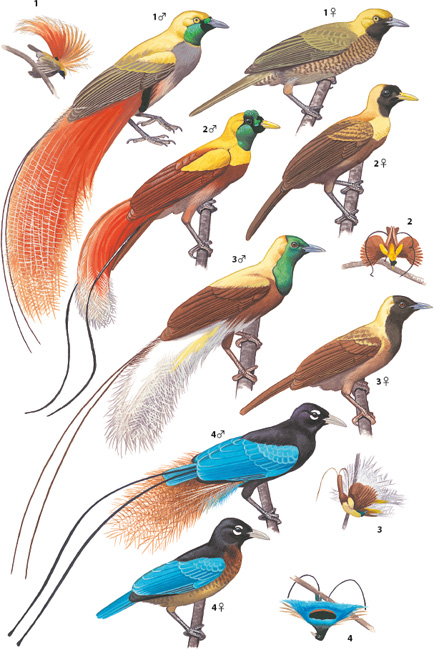
PLATE 100 BIRDS OF PARADISE—PARADISAEAS WITH LARGE RANGES
These are the iconic birds of paradise, and one—the Raggiana Bird of Paradise—is the national bird of Papua New Guinea. Each of these 3 closely related species is confined to an exclusive geographic area of mainland New Guinea. Males display in leks high in the treetops.

|
1 Greater Bird of Paradise Paradisaea apoda
Male 43 cm, Female 35 cm. SW NG and Aru Is. Male has yellow-and-white flank plumes; from male Lesser BoP by larger size, brown back sharply contrasting with yellow nape, and prominent blackish breast cushion. Female, Juv, Imm are entirely brown; note bright yellow eye and pale blue bill to separate it from the other large, all-brown songbirds with which is may associate. Hybridizes with Raggiana BoP at Fly R (Kiunga). |
p. 486 |

|
2 Lesser Bird of Paradise Paradisaea minor
Male 32 cm. The plumed BoP of the North and West. Male has yellow-and-white flank plumes; from male Greater BoP by smaller size, yellow mantle and wing-coverts, and absence of blackish breast-cushion. Female, Juv, Imm have unique snowy white breast and belly. Hybridizes with Raggiana BoP in upper Ramu R and Huon Pen, and with Emperor BoP. |
p. 485 |

|
3 Raggiana Bird of Paradise Paradisaea raggiana
33–34 cm. E NG. Male has reddish or orange flank plumes. Female, Juv, Imm exhibit diagnostic yellowish crown and nape framing the dark face, dark brown breast, and maroon-brown belly. Subspp shown: salvadorii (S NG east to SE Pen; E Ranges) brown mantle, brick red flank plumes; augustaevictoriae (Huon and northwestern SE Pen) yellow dorsally, orange plumes. Not shown are raggiana (far SE NG) yellow mantle, reddish flank plumes and intermedia (N coast of SE NG) like previous but much yellow dorsally. |
p. 486 |
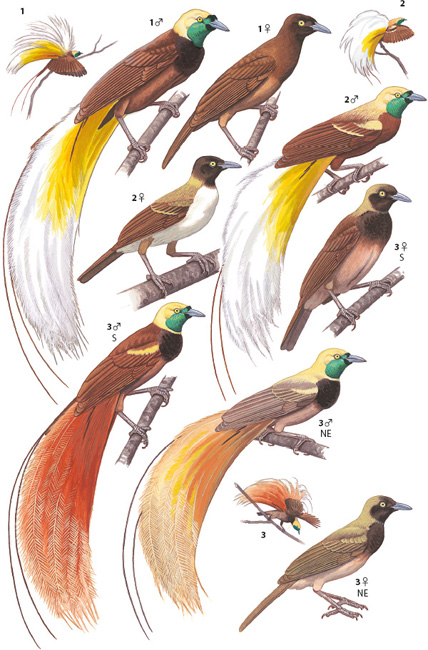
PLATE 101 LOWLAND ROBINS, TORRENTLARK, AND MAGPIELARK

|
1 Mangrove Robin Peneothello pulverulenta
14–15 cm. Mangroves along NG coasts and some rivers. Common but patchily distributed. Adult is grey with white throat, white in tail, and all-dark wings. Juv brown above, whitish below, streaked and flecked throughout. Subsp shown: pulverulenta (NG). Not shown is leucura (Aru Is and AU), head and breast greyer. |
p. 492 |

|
2 Jacky Winter Microeca fascinans
14 cm. Port Moresby savannah. Scarce and local. Adult dingy brown above, whitish below, with diagnostic white outer tail feathers. Juv similar but spotted. |
p. 489 |

|
3 Black-chinned Robin Heteromyias brachyurus
14–15 cm. Northern lowlands and hills. Uncommon in forest interior. Black-and-white Adult has thick white eyebrow and black chin. Note pale legs, compared with dark legs of the more common Black-sided R. Juv, like Adult but heavily smudged with brown. Subsp shown: dumasi (NW Lowlands and Sepik-Ramu) back black. Not shown is brachyurus (Bird’s Head and Neck, far W Ranges) back dark grey. |
p. 491 |

|
4 Black-sided Robin Poecilodryas hypoleuca
13–15 cm. The common robin of lowland and hill forest. Adult is black and white with distinctive facial pattern; note black mark on side of the breast. Juv brown with white belly and undertail-coverts. |
p. 492 |

|
5 Torrent Flycatcher Monachella muelleriana
14–15 cm. Forages over rocky streams and rivers from foothills up to the transition to cloud forest. In both primary forest and disturbed habitat. Locally common. Adult is whitish with bold black cap, wings, and tail. Juv shows same pattern but lacks the white supraloral spot and is faintly pale-spotted and brownish-mottled. |
p. 490 |

|
6 White-rumped Robin Peneothello bimaculata
13–14 cm. Hill forest understory. Uncommon and local. Adult jet black with white on rump. Juv sooty brown with reduced amounts of white. Subspp shown: bimaculata (species range except next) belly white; vicaria (Adelbert Mts to N slopes of SE Pen) Male’s belly black, Female’s partly white. |
Pl. 104, p. 492 |

|
7 Torrentlark Grallina bruijnii
20 cm. Along fast-flowing creeks and rivers in the mountains. Prefers primary forest and steep terrain. Scarce but easily located noisy pairs and family groups. Bobs body and wags its tail. Male with black face and underparts. Female with white brow and breast. Juv like Female but forehead black and eyebrow white. |
p. 462 |

|
8 Magpielark Grallina cyanoleuca
26 cm. S Trans-Fly. Common in grassland with scattered trees and along river courses. Struts about wagging its tail. Male with white eyebrow and black throat. Female with white forehead and throat. Juv with white eyebrow and throat and dark eye. |
p. 463 |
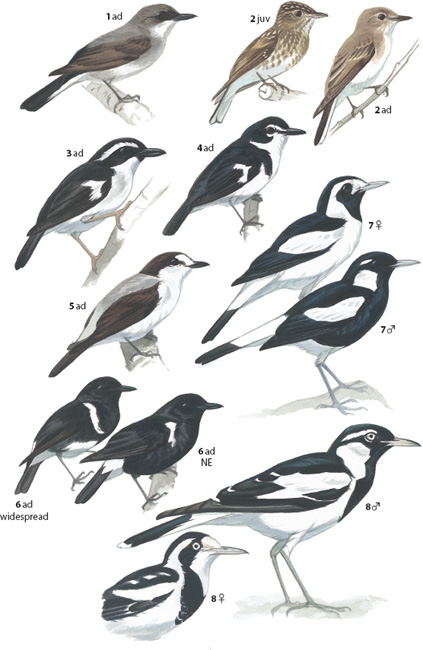
PLATE 102 HIGHLAND ROBINS

|
1 Snow Mountain Robin Petroica archboldi
14 cm. Restricted to a few peaks in the W Ranges. Inhabits rocky alpine scree well above the tree line. Conspicuous and noisy. Adult with red breast patch, lacking in Juv. |
p. 488 |

|
2 Subalpine Robin Petroica bivitatta
11–12 cm. Subalpine forest, shrubland. Uncommon, local. Black with white breast and forehead spot. Male black. Female sooty black. Subsp shown: bivittata (E Ranges, SE Pen) outer tail mostly white. Not shown is caudata (W Ranges), little white in tail. |
p. 488 |

|
3 Blue-grey Robin Peneothello cyanus
14–15 cm. The common understory robin at the transition between mid-mountain and cloud forest. Adult bluish grey. Juv grey with brown shaft streaking and spotting. |
p. 493 |

|
4 Smoky Robin Peneothello cryptoleuca
14–15 cm. Mid-mountain and cloud forest in the West. Common. Adult smoky grey. Subsp shown: cryptoleuca (Bird’s Head, Foya Mts) underparts entirely grey. Not shown are albidior (W Ranges) similar and maxima (Kumawa Mts) underparts white. |
p. 493 |

|
5 White-winged Robin Peneothello sigillata
14–15 cm. Cloud forest and timberline. Common. Adult velvety black with a white wing patch. Juv plumage similar but overlaid with brown markings. Subspp groups shown: sigillata (species range except next); quadrimaculata (W Ranges) white patch on side of breast. |
p. 492 |

|
6 Ashy Robin Heteromyias albispecularis
15–16 cm. Bird’s Head representative of Black-capped R, but overall grey and less patterned. |
p. 491 |

|
7 Black-capped Robin Heteromyias armiti
15–18 cm. Forest floor and understory of lower cloud forest. Uncommon. A medium-large robin with long, pale legs. Black cap, white eyebrow, white throat patch. Male bill tipped white. Subsp shown: armiti (SE Pen, Huon) greenish-olive back. Not shown is rothschildi (W Ranges to E Ranges) olive brown back. |
p. 491 |

|
8 White-eyed Robin Pachycephalopsis poliosoma
15–16 cm. The common and vocal grey robin of mid-montane forest understory, but difficult to observe. Adult with white iris and throat. Juv tinged brown. Subspp shown: poliosoma (SE Pen) large white throat patch and undertail grey, not buffy; hypopolia (Huon and Adelbert Mts) a small, dark race, with buff in the undertail. |
p. 488 |

|
9 Black-throated Robin Plesiodryas albonotata
18–19 cm. Mid-mountain and cloud forest midstory. Uncommon. High, tonelike song. Adult with black face marked by a white streak. Juv pale cinnamon. Subspp shown: albonotata (Bird’s Head) and correcta (SE Pen, Huon) underparts mostly white; griseiventris (W Ranges to E Ranges) underparts mostly grey. |
p. 491 |
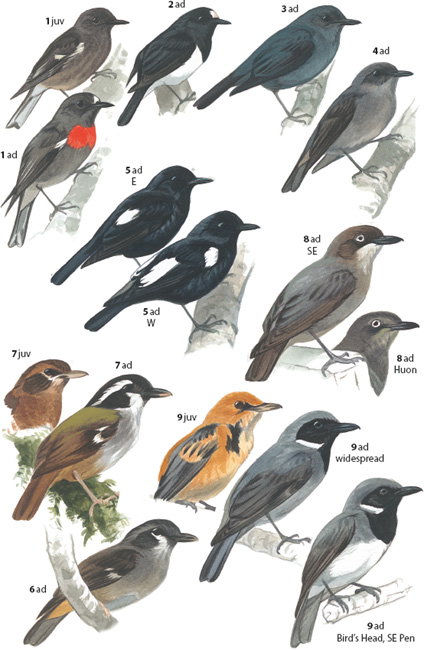
PLATE 103 YELLOW AND GREEN ROBINS AND FLYCATCHERS

|
1 Olive Flycatcher Kempiella flavovirescens
13–14 cm. Lowland and hill forest. Common in midstory. Adult is yellowish olive and plain but for its yellow lower bill and legs. Has the most obvious eye-ring of any flycatcher. Juv brown above with pale spots; white eye-ring, yellowish legs. |
p. 489 |

|
2 Yellow-legged Flycatcher Kempiella griseoceps
12–13 cm. Mid-mountain forest and Trans-Fly. Frequents subcanopy and midstory. Local, uncommon, and inconspicuous. Adult a small robin with unique combination white throat, pale yellow breast, and yellow legs. Juv brown with pale spotting. |
p. 489 |

|
3 Papuan Flycatcher Devioeca papuana
12–13 cm. Cloud forest. Common. Adult has rich yellow underparts and bright orange legs. Juv brown and green above, heavily pale-spotted; yellow legs. |
p. 489 |

|
4 Lemon-bellied Flycatcher Microeca flavigaster
12–13 cm. Savannah and large clearings in the forest, from lowlands to mountain valleys. Patchily distributed but locally common. Adult differs from other yellow-breasted flycatchers by its all-black legs and bill (may be pale at base of lower bill). Juv brown and pale-spotted above; white with brown markings below. Subspp poorly understood but varying in brightness of yellow. |
p. 490 |

|
5 Garnet Robin Eugerygone rubra
10–11 cm. A petite, fantail-like robin, local and rare in montane cloud forest. Perches horizontally; nervously jerks about and flashes wings, showing white blaze across flight-feathers and white in tail. Male has maroon-red upperparts, green in Female. Juv reddish brown, paler below. |
p. 488 |

|
6 White-faced Robin Tregellasia leucops
11–13 cm. Mid-mountain forest. A common bird of the understory and midstory. There is also a population in S Lowlands. Adult has white face. Juv is extensively smudged with brown; only a hint of adult facial pattern. Subspp groups shown: leucops (Bird’s Head to S slope of W Ranges) no white eye-ring, black forehead line; melanogenys (mts of NW Lowlands to Huon) white eye-ring, bill mostly black. Not shown are wahgiensis (E Ranges, S Lowlands) white eye-ring, bill mostly orange and albifacies (SE Pen) white eye-ring, black forehead stripe, bill mostly black. |
p. 493 |

|
7 Banded Yellow Robin Gennaeodryas placens
14–15 cm. Hill forest. This understory robin rarely encountered because of patchy distribution and restriction to a narrow elevational band. Adult has unusual color pattern with brilliant yellow half-collar. Juv similar but tinged brown. |
p. 493 |

|
8 Green-backed Robin Pachycephalopsis hattamensis
15 cm. Common in understory of mid-mountain forest of W NG. Adult a white-eyed robin with whistler-like plumage pattern. |
p. 487 |
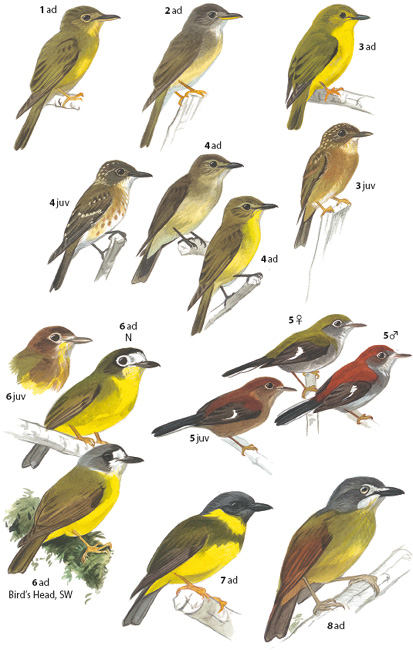
PLATE 104 OPEN COUNTRY SONGBIRDS

|
1 Long-tailed Shrike Lanius schach
25 cm. Montane grasslands and gardens. Common. Adult unique. Juv has black mask. |
p. 458 |
|
2 Brown Shrike Lanius cristatus
18 cm. Vagrant Palearctic migrant to open habitats in far West. Black mask, white eyebrow. |
p. 458 |
|
3 Blue Rock-thrush Monticola solitarius
20–23 cm. Vagrant Palearctic migrant to rocky places and shores. |
p. 507 |
|
4 Siberian Rubythroat Luscinia calliope
14–16 cm. Vagrant Palearctic migrant to open country and thickets. |
p. 507 |

|
5 Grey-streaked Flycatcher Muscicapa griseisticta
13–14 cm. Overwintering Palearctic migrant in lowlands to mid-mountains. On high, open perches at forest edge, gardens. Dark streaked below, white spot in front of eye. |
p. 508 |

|
6 Pied Bushchat Saxicola caprata
14–15 cm. Grasslands, gardens, edge of towns. Montane, locally in lowlands. Common. Male black with white rump and shoulder. Female dull grey; note white rump and undertail. Juv similar with buff spots above and buff wing bars. |
p. 507 |
|
7 White-rumped Robin Peneothello bimaculata
14–15 cm. For comparison. Completely different habitat: hill forest interior. |
Pl. 101, p. 492 |
|
8 Eurasian Tree Sparrow Passer montanus
14 cm. Not native; spreading. Established in many ports and towns, mainly on Indonesian side. All plumages show black spot on ear-coverts, chestnut crown. |
p. 510 |
|
9 House Sparrow Passer domesticus
15 cm. Not native; spreading. Common in a few ports, towns, and cities. Male facial pattern unique. Female and Juv drab with pale eye-stripe. |
p. 510 |

|
10 Horsfield’s Bushlark Mirafra javanica
13 cm. Short grass, roadsides, airfields from lowlands to mid-mountains. Hesitant, mothlike flight unique. Conical, stubby bill; much streaking; rufous patches on wings; white outer tail feathers. Plumage darker with wear. |
p. 494 |

|
11 Australasian Pipit Anthus novaeseelandiae
15 cm. Montane grasslands and dry lowlands of NE. Slender profile, thin bill, pinkish legs, white outer tail feathers. Streaked breast. Juv, pale edges to feathers of upperparts. |
p. 516 |

|
12 Alpine Pipit Anthus gutturalis
18 cm. Alpine grasslands. A heavyset, dark pipit. Adult, dark unstreaked breast, white “spectacles” and throat, black “eye shadow.” Juv darker than Australasian P. |
p. 516 |

|
13 Eastern Yellow Wagtail Motacilla t. tschutschensis
16–17 cm. Uncommon Palearctic migrant, mainly in lowlands. Short grass and bare areas. Black legs; tail not longer than body. Lacks yellow rump and white wing-stripe in flight. Nonbreeding adult brown-olive above, pale yellow below. Breeding adult has grey cap. Imm like Nonbreeding adult but more variable; often white below. |
p. 515 |
|
14 Green-headed Yellow Wagtail
Motacilla tschutschensis taivana 16–17 cm. Hypothetical. Yellowish eyebrow. Breeding adult’s crown green, same as back. |
p. 515 |

|
15 Grey Wagtail Motacilla cinerea
18–19 cm. Palearctic migrant, mainly in the mountains. Near water: creek beds, wet gravel roads. Pale legs, tail longer than body. Yellow rump. Flashes white wing-stripe and tail feathers in flight. Nonbreeding adult and Imm have yellow breast, white throat. Breeding adult is bright yellow below, and Male has black throat. |
p. 516 |
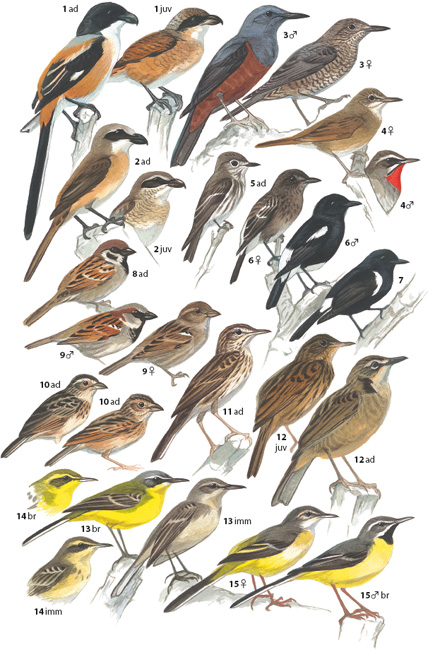
PLATE 105 “SYLVIID” WARBLERS

|
1 Numfor Leaf-Warbler Phylloscopus maforensis
9–10 cm. The only leaf-warbler on Numfor I. Dull grey; head pattern obscure. |
p. 497 |
|
2 Biak Leaf-Warbler Phylloscopus misoriensis
9–10 cm. The only leaf-warbler on Biak I. Note orange legs and bill. Relatively long-legged. |
p. 497 |

|
3 Island Leaf-Warbler Phylloscopus poliocephalus
9–10 cm. Montane forests. Common. Note yellowish wash on underparts, dark eye-line and crown, pale eyebrow. Subspp groups shown: poliocephalus (Bird’s Head and Neck) grey crown lacks median stripe; giulianettii (mainland minus range of previous) grey crown with pale mid-stripe; hamlini (D’Entrecasteaux Is) blackish crown with pale mid-stripe. |
Pl. 77, p. 497 |
|
4 Gray’s Grasshopper-Warbler Locustella fasciolata
17–18 cm. Rare Palearctic migrant. Skulks in dense underbrush and tall grass. From reed-warblers by stocky build and pale, pinkish legs. Adult greyish below, Juv yellowish. |
p. 501 |
|
5 Oriental Reed-Warbler Acrocephalus orientalis
18 cm. Rare Palearctic migrant in cane, reeds, sedges bordering wetlands. Distinguish with care from Australian RW by song and dusky streaking on sides of throat. |
p. 501 |

|
6 Australian Reed-Warbler Acrocephalus australis
16–17 cm. Resident, patchily distributed. A retiring songster of tall reeds and other grasses, often near water. Plain brown with faint pale eyebrow and dark legs. |
p. 501 |

|
7 Golden-headed Cisticola Cisticola exilis
10–11 cm. Widespread, common. Tiny, long-legged warbler in grassland. Buffy nape and flanks. Breeding male: head buff, tail short. Female and Nonbreeding: crown streaked. |
p. 503 |

|
8 Zitting Cisticola Cisticola juncidis
10–11 cm. Trans-Fly. Grass hummocks. From Golden-headed C: zitting or clicking song; more streaked above; less buffy; and conspicuous pale tail tip. Breeding male: crown not streaked, tail short; note eyebrow. Female and Nonbreeding: crown streaked. |
p. 503 |
|
9 Little Grassbird Megalurus gramineus
14–15 cm. Local and little known. Hides in marsh vegetation. Small, with dark, streaked crown. |
p. 503 |

|
10 Fly River Grassbird Megalurus albolimbatus
14–15 cm. Trans-Fly marshes. Local, but common where found. Clean white underparts; bright, unstreaked rufous cap; prominent white eyebrow; shortish tail. |
p. 502 |

|
11 Tawny Grassbird Megalurus timoriensis
18–21 cm. Trans-Fly grasslands. From Papuan GB: tawnier, cap streaked. Juv from adult Tawny by reduced eyebrow, diffuse streaking; from juv Papuan by lack of yellowish wash. |
p. 502 |

|
12 Papuan Grassbird Megalurus macrurus
20–23 cm. Widespread except Trans-Fly. Grassland. Longer tail tapers to finer point. Adult’s cap unstreaked, breast white. Juv cap and breast streaked. Subspp groups shown: macrurus (widespread, exclusive of next race) not streaked below; alpinus (Central Ranges above 2500 m) streaked flanks. |
p. 502 |
|
13 Green-backed Gerygone Gerygone chloronota
8–9 cm. For comparison. Gerygones differ from leaf-warblers by absence of crown striping. |
Pl. 77, p. 427 |
|
14 White-shouldered Fairywren
Malurus alboscapulatus 12 cm. For comparison. Female in S NG similar to Fly River Grassbird. |
Pl. 68, p. 402 |
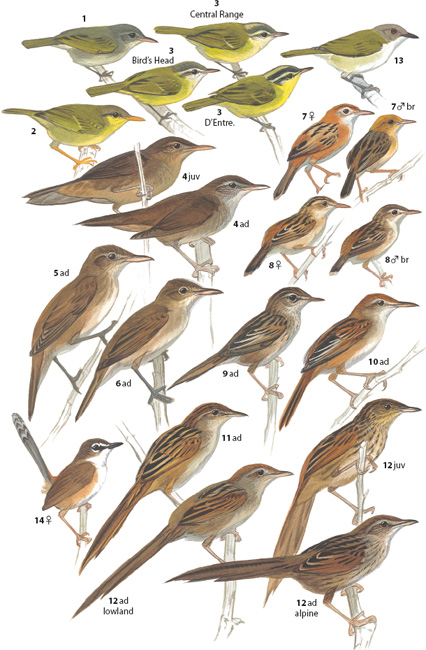
PLATE 106 WHITE-EYES

|
1 Green-fronted White-eye Zosterops minor
11 cm. Northern counterpart of Black-fronted WE. Common. Differs by eye-ring absent or nearly so, forehead always green, and upperparts brighter yellow-green. |
p. 499 |

|
2 Black-fronted White-eye Zosterops atrifrons
11 cm. Hill and lower montane forests. Common. From New Guinea WE: dark forehead and yellow throat sharply delineated from white breast, except on Bird’s Head where Black-fronted may have green forehead and New Guinea WE also has sharply defined yellow throat. Here, look for Black-fronted’s brighter white flanks, breast, and belly, whereas those of New Guinea WE are dingy. Subspp groups shown: chrysolaemus (mostly in South) eye-ring medium width, forehead black or dark green; delicatulus (southern SE Pen, D’Entrecasteaux Is) broad eye-ring, black mask. |
p. 498 |

|
3 New Guinea White-eye Zosterops novaeguineae
11 cm. To separate from Black-fronted WE, see above account. Subspp (4 groups): wuroi (Trans-Fly, Aru Is) small, with yellow throat sharply defined, eye-ring wide; crissalis (mts from E Ranges to SE Pen) yellow throat grading into white breast. Not shown are: novaeguineae (mts of Bird’s Head/Neck) see Black-fronted account, above; and magnirostris (coast at Ramu R) breast with prominent yellow streak. |
p. 500 |

|
4 Tagula White-eye Zosterops meeki
11 cm. The only white-eye on Tagula I (SE Is). Sister species to Black-fronted WE, with similar song. Uncommon in hill forests. All-white throat and breast. |
p. 499 |

|
5 Lemon-bellied White-eye Zosterops chloris
12 cm. On a few islets and small islands in the NW Is and Aru Is. Only white-eye where it occurs; abundant. Bright yellow underparts. |
p. 498 |

|
6 Biak White-eye Zosterops mysorensis
11 cm. The only white-eye on Biak. Uncommon. Lacks white eye-ring. Note yellow vent. |
p. 499 |

|
7 Capped White-eye Zosterops fuscicapilla
11 cm. The uniformly olive white-eye of W mts. Locally common in forest, regrowth, and gardens. Olive-green with black cap. |
p. 499 |

|
8 Oya Tabu White-eye Zosterops crookshanki
11 cm. The montane, cloud forest white-eye in the D’Entrecasteaux Is. Locally common. Differs from Capped WE by the wider eye-ring and silver-grey iris. Crown and face dark green on Goodenough I (shown), blackish on Fergusson I. |
p. 499 |

|
9 Louisiade White-eye Zosterops griseotinctus
11–13 cm. Small SE Is. Abundant. Large, olive green with large bill. Subspp groups shown: griseotinctus (small SE Is) greyish legs, plumage variably olive to yellow-green; pallidipes (Rossel I) orangish legs, plumage yellow-green. |
p. 500 |
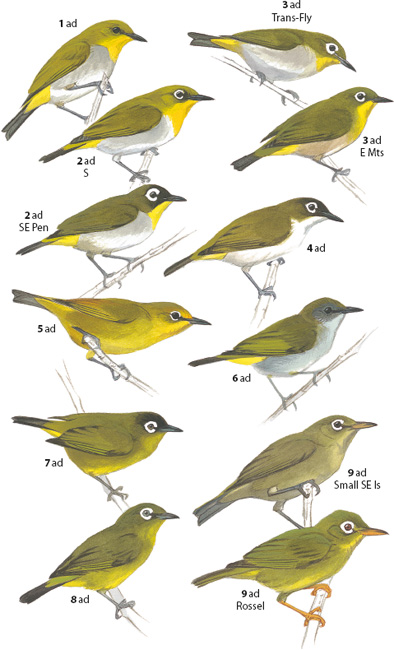
PLATE 107 DRONGOS AND STARLINGS

|
1 Pygmy Drongo Chaetorhynchus papuensis
20 cm. Interior of hill and mid-mountain forests, where it is the only black flycatcher-like bird with upright posture and unforked tail. Common. Juv duller; white gape. |
p. 467 |

|
2 Spangled Drongo Dicrurus bracteatus
25–28 cm. Ubiquitous in forest and edge from lowlands to mid-mountains. Sits upright; note unique “fish tail.” Adult glossy with red iris. Juv duller; dark iris. Subspp shown: bracteatus (AU migrant, winters mainly in Trans-Fly) larger, tail shorter and less forked, bill longer, Juv with white tips to undertail-coverts; carbonarius (widespread resident). |
p. 466 |
|
3 Common Myna Acridotheres tristis
23–25 cm. Hypothetical introduction. Reported from Alotau (SE Pen). A bird of cities and towns. Seen perched on wires or walking on lawns and roadsides. |
p. 506 |
|
4 Sooty-headed Bulbul Pycnonotus aurigaster
15–20 cm. Introduced to Biak I and Jayapura. A conspicuous, garrulous, easily recognized bird of towns and countryside. Pale rump and white tail tip. Juv face and cap brownish. |
p. 494 |

|
5 Singing Starling Aplonis cantoroides
19–22 cm. Lowland towns, deforested areas, seacoast, forest edge. Common. Short, square tail. Adult black; iris orange-red. Juv brown above, whitish and streaked below; iris dark brown. Imm similar, darker above, more heavily marked, iris red. |
p. 504 |

|
6 Moluccan Starling Aplonis mysolensis
20 cm. NW Is only, mainly small islands. Local and uncommon in forest and open habitats. Wedge-shaped tail, dark eye. Adult all black. Juv brown above, white below with dark streaking. |
p. 505 |

|
7 Metallic Starling Aplonis metallica
22–24 cm. Lowland and hill forest and edge. Common. Pointed tail. Adult with green and purple gloss, hackles, and red iris. Juv dark brown above, white below with streaking; iris brown. Imm upperparts like Adult, underparts like Juv; iris red. Subsp shown: metallica (widespread, range exclusive of next race). Not shown is inornata (Bay Is of Biak and Numfor) smaller and less iridescent. |
p. 504 |

|
8 Yellow-eyed Starling Aplonis mystacea
20 cm. Uncommon relative of Metallic S, with which it associates. White iris is the best field mark. Other differences harder to see include the scant crest and stubbier profile. Plumages same as for Metallic S. |
p. 504 |

|
9 Long-tailed Starling Aplonis magna
28–41 cm. Bay Is only. Abundant. Very long, lax tail. Dark iris. Female smaller. Juv duller and tail shorter. Subspp shown: magna (Biak I) larger, with longer tail; brevicauda (Numfor I) smaller, with shorter tail. |
p. 505 |
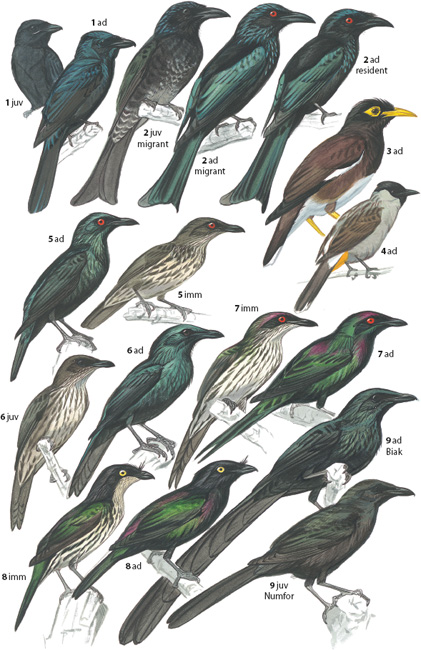
PLATE 108 CATBIRDS, ORIOLES, AND MYNAS

|
1 Black-eared Catbird Ailuroedus melanotis
28–29 cm. Catbirds are green bowerbirds that do not build bowers; they are vocal but very shy. The species differ in habitat. This one found in 2 habitats: lower mountains and stands of rainforest/monsoon forest in the Trans-Fly. Black ear-patch and blackish chin. Tail with white tip, lacking in White-eared CB. Breast scalloped rather than spotted. Much regional variation. Shown are 2 of the 8 subspp: melanotus (Trans-Fly and Aru Is); arfakianus (Bird’s Head and Neck). |
p. 396 |

|
2 White-eared Catbird Ailuroedus buccoides
24–25 cm. The catbird of lowland and foothill forest interior. Black-spotted breast, white throat and ear-patch, prominent uniform cap, and lacks white tail tip. Subspp groups shown: geislerorum (NW Lowlands to northern SE Pen) pale brown crown; buccoides (widespread, exclusive of previous subsp) dark crown. |
p. 396 |

|
3 Brown Oriole Oriolus szalayi
25–28 cm. Lowlands into mid-mountains. Common in forest canopy and regrowth. Adult has blackish face patch and blood-red iris and bill. Juv has white eyebrow, black face, dark brown iris, and blackish bill; don’t mistake it for a friarbird. |
p. 459 |

|
4 Olive-backed Oriole Oriolus sagittatus
25–28 cm. Trans-Fly savannah, where locally common. Upperparts grey-olive and underparts white with sharp, dark streaking. Adult, red iris and bill. Juv greyer; dark iris and bill, pale eyebrow, and buff edges to wing feathers. |
p. 459 |

|
5 Green Oriole Oriolus flavocinctus
25–28 cm. Trans-Fly, where common in all wooded habitats. Adult yellow-green; dark wings and tail tipped white; iris and bill red. Rare grey morph. Juv duller olive with heavier streaking; pale eyebrow; dark iris and bill. |
p. 459 |

|
6 Australasian Figbird Sphecotheres vieilloti
27 cm. Open wooded habitats and trees in towns. Locally common. Male unique. Female and Juv whitish below and heavily streaked; dark eye and grey facial skin. |
p. 458 |

|
7 Golden Myna Mino anais
24 cm. Lowland forest, where uncommon. Adult black with orange neck. Juv head black, underparts mottled black and yellow. Rump yellow (not white). Subspp groups shown: orientalis (main trunk of NG) yellow crown, black nape, lacks yellow eye patch; anais (NW Is, W Bird’s Head) head black, pale patch behind eye. |
p. 505 |

|
8 Yellow-faced Myna Mino dumontii
25–26 cm. Lowland and hill forest canopy, particularly at edge of clearings or along river courses. Common, vocal, and conspicuous. Adult has bright yellow-orange facial skin and white rump, conspicuous in flight. Juv facial skin paler. |
p. 505 |
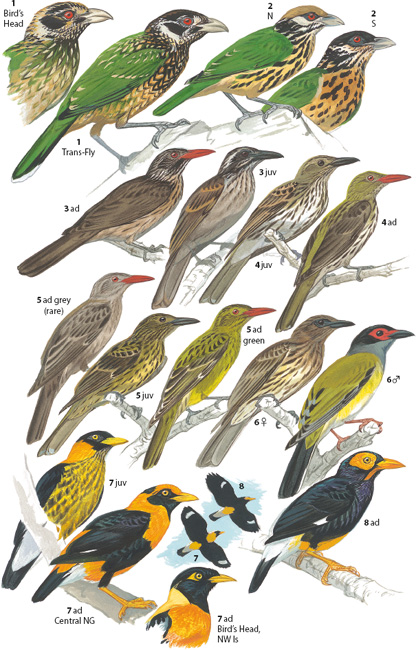
PLATE 109 FINCHES 1

|
1 Crimson Finch Neochmia phaeton
13 cm. Lowlands, where locally common in tall grass bordering rivers, marshes, and lakes. A slender, red-and-grey finch with long, pointed, red tail. Adult has red face and beak; breast red in Male, grey in Female. Juv has brown head and breast, dark beak. |
p. 511 |

|
2 Mountain Firetail Oreostruthus fuliginosus
13 cm. Subalpine forest edge and glades, where inconspicuous but locally common. Seen on the ground or in low shrubbery. Adult has red flanks and beak. Throat of Male is same dark brown as rest of head; orange-brown in Female, with upper beak dark. Juv brown except for red rump; beak black. |
p. 511 |

|
3 White-spotted Mannikin Lonchura leucosticta
10 cm. Uncommon in grassy habitats in lowlands, also bamboo and forest edge. Adult is warm brown with white chin and cheeks and fine white speckling on head and foreparts. Juv, spots on wing-coverts; from juv Streak-headed M by pale chin. |
p. 513 |

|
4 Grey-headed Mannikin Lonchura caniceps
10 cm. Grasslands of lowlands and mid-mountains. Common. Adult grey head contrasts with dark beak and beady eye. Juv plain tan with dark bill. Subspp groups shown: caniceps (lowlands) darker, belly and flanks blackish, rump orange; scratchleyana (mountains) paler, belly and flanks buff, rump yellow. |
p. 513 |

|
5 Grey-banded Mannikin Lonchura vana
10 cm. Mid-mountain grasslands of Bird’s Head. Adult has white face; unique chestnut breast bordered above by grey band. Juv plain tan; note orangish rump and belly. |
p. 513 |

|
6 Grey-crowned Mannikin Lonchura nevermanni
11 cm. Trans-Fly marshes, riverine grasses, and nearby savannah. Local, but common where found. Adult has white cap, black throat, rich brown underparts. Head often darker in Female. Juv tan with pale bill. |
p. 513 |

|
7 Papuan Parrotfinch Erythrura papuana
13 cm. Same habitats as the nearly identical Blue-faced PF, with which it may co-occur, but patchily distributed and very rare. Difficult to separate in the field. Differs in larger size and more massive beak with somewhat more swollen shape. |
p. 512 |

|
8 Blue-faced Parrotfinch Erythrura trichroa
12 cm. Hills and mountains, in forest and edge; common but difficult to observe. Listen for its call—an insect-like, short, descending, high-pitched trill, t-t-t-t. From Papuan PF by smaller size and smaller, narrower, straight-edged, conical beak. Adult has blue face; Female paler green below. Juv face mostly green, tail brownish red. |
p. 511 |
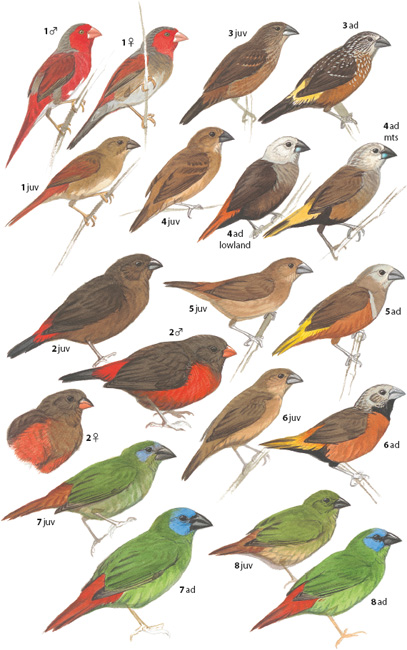
PLATE 110 FINCHES 2

|
1 Chestnut-breasted Mannikin Lonchura castaneothorax
10 cm. Grassy areas, mostly in lowlands, also mid-mountains. Locally common, nomadic. Adult has tan breast, black breast band, white belly; pale nape contrasts with black face. Juv has buff breast band and blue-grey bill. Subspp groups shown: sharpii (NW Lowlands to Sepik-Ramu) grey crown; ramsayi (SE Pen) head nearly all dark. Not shown is boschmai (western W Ranges) brown scalloping on flank. |
p. 514 |

|
2 Hooded Mannikin Lonchura spectabilis
10 cm. Grassy areas, lowlands to mid-mountains. Locally common, nomadic. Adult has simple pattern: black hood, brown saddle, and breast and belly of a contrasting color (varies by locale). Juv has dark ear-patch, very pale underparts, no breast band. Much geographic variation, but poorly understood. |
p. 514 |

|
3 Western Alpine Mannikin Lonchura montana
11–12 cm. Alpine grassland and moors. Adult has black crown and face, buff breast, barred flanks. Juv larger than juv Black-breasted M; lacks the obscure breast streaking. |
p. 515 |
|
4 Black-faced Mannikin Lonchura molucca
10–11 cm. Only finch on the islands of Gag and Kofiau (NW Is). Adult has black throat and bib; unique white, scaly breast and rump. Juv tan, paler below, with cream rump. |
p. 512 |

|
5 Eastern Alpine Mannikin Lonchura monticola
11–12 cm. Alpine grasslands and moors. Locally common. Adult has white breast, black lower breast band and flank-stripe. Juv, large; blackish face; faintly streaked breast band. |
p. 515 |

|
6 Black-breasted Mannikin Lonchura teerinki
11 cm. Mid-mountain grasslands of W Ranges. Common. Adult has black head, breast, and flank streak. Juv smaller than juv Western Alpine M and has streaked breast. |
p. 514 |

|
7 Grand Mannikin Lonchura grandis
12 cm. Open grasslands and marshes of lowlands and lower mountains. Uncommon, local. Large. Big-headed. Note massive, bluish-white beak. Adult has black head and underparts, chestnut wings and flanks. Juv head dark, breast with smudgy streaks. |
p. 513 |

|
8 Black Mannikin Lonchura stygia
11 cm. Wetland grasses of W Trans-Fly. Local common. Adult black with yellow tail and rump. Juv creamy white below with smudgy streaking on breast; note streaky head. |
p. 514 |

|
9 Streak-headed Mannikin Lonchura tristissima
10 cm. The mannikin of forest edge and second growth in lowlands to mid-mountains. Uncommon. Adult blackish with yellow rump and black tail. Juv uniform dull brown. Subsp group shown: tristissima (N watershed) no spotting in underparts. Not shown is bigilalei (southern SE Pen) whitish spots along flanks. |
p. 512 |
